#four hours of playtime (2 hours progressed)
Explore tagged Tumblr posts
Text
Friend and I were playing FW and we spent two hours not even playing and just talking about stuff like how natural the animations and expressions feel alsjskf
#girlbob.txt#four hours of playtime (2 hours progressed)#aloy's hair also looked beautiful imo#had this pseudo painterly effect to the shading when youre controlling her (as opposed to cutscene)#that we were both like 'if dav manages even half of that the hair will be beautiful'#we also talked about like. games that integrate the hud into the actual game and how neat that is#as well as how the tutorial level did a pretty good job of 1. not making aloy and idiot and 2. explaining why shes weaker than endgame of 1#(hi tali ily)
0 notes
Text
A Disappointing Early Foray into 3D Metroidvania - Castlevania: Lords of Shadow 2
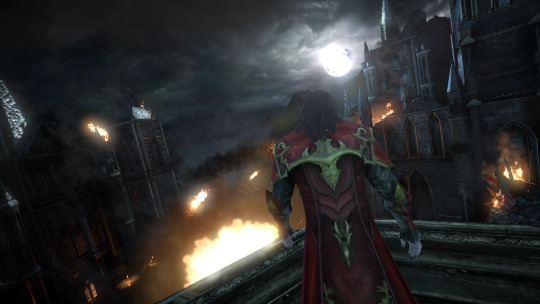
1. Introduction
Game Title: Castlevania: Lords of Shadow 2
Release Date: Feb 26, 2014 (PC)
Genre: 3D Metroidvania, Action-adventure, Hack and Slash
Playtime: 15-30 hours
Overview:
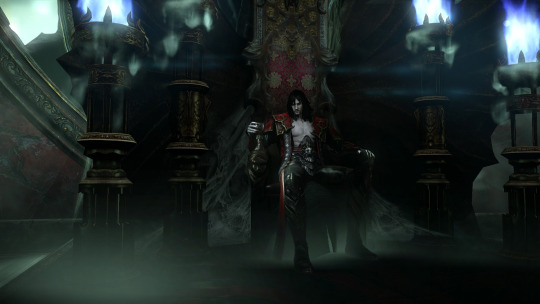
Castlevania: Lords of Shadow 2 marks the conclusion of the Lords of Shadow saga and, regrettably, stands as the last major installment in the Castlevania series to date. Departing from its predecessor, Lords of Shadow 2 builds upon the excellent dark gothic art style and God of War-esque combat of the first game by reintroducing the Metroidvania exploration mechanics that are classic to the Castlevania franchise. Players navigate through the sprawling Vampire Castle and a dark, gothic-infused modern city, gradually unlocking abilities such as bat transformation, mist form, and double jump. These new powers grant access to hidden areas, allowing for encounters with a diverse array of enemies, including vampires, skeleton warriors, demons, cyberpunk soldiers, and cyberpunk mechs, interspersed with a handful of stealth sections.
2. Gameplay Mechanics
Story-Driven 3D Metroidvania Exploration:

This installment cleverly integrates the core mechanics of the classic 2D Metroidvania gameplay – the gradual acquisition of abilities to unlock and explore new areas – into a 3D environment. The game features two expansive maps: Castlevania City and Dracula’s Castle. Each of these is divided into four freely explorable levels, which in turn contain numerous interconnected sub-levels. Scattered throughout these environments are hidden zones accessible only by utilizing newly acquired abilities or solving environmental puzzles, often rewarding players with health upgrades or lore-rich collectibles.
However, unlike typical Metroidvania titles, the main story progression in Lords of Shadow 2 feels more akin to a linear action-adventure game. Players are driven by the narrative, moving from objective to objective, defeating level bosses, unlocking new abilities, and then being transported via the story to new areas for further adventure. This contrasts with the traditional Metroidvania experience of freely exploring a map, encountering initially inaccessible regions, unlocking new abilities in specific areas, and then using these abilities to reach previously unreachable zones.
Consequently, players primarily focused on the main storyline might perceive the game as a linear, level-based action-adventure title. The Metroidvania exploration elements, in this context, feel more like an afterthought. This is where my greatest disappointment lies. Mercury Steam had the potential to deliver a compelling 3D Metroidvania exploration experience, akin to STAR WARS Jedi: Fallen Order™. Had they focused on this, the game could have garnered higher critical acclaim and sales. Mercury Steam possessed the capability to create a flawless 3D Metroidvania exploration game, but they ultimately produced a mixed bag of gameplay modes that diluted its core mechanics.
God of War-Like Hack and Slash:
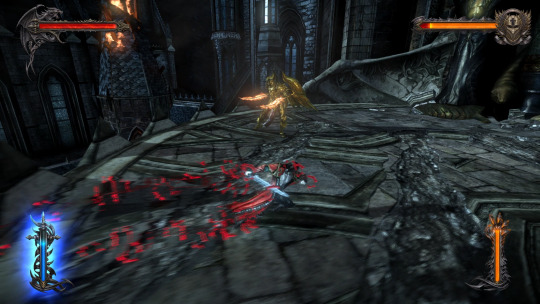
If the combat experience of the original Lords of Shadow resembled early God of War titles, with colossal bosses, QTEs, and the Blades of Chaos-inspired Combat Cross, then Lords of Shadow 2’s combat leans more towards the style of Devil May Cry. The combat tempo is significantly faster, with Dracula capable of continuous, multi-directional high-speed dashes. Players can swiftly switch between three distinct weapon types, each boasting a comprehensive move list, allowing for fluid execution of various moves to dispatch enemies in high-octane, rapid-fire encounters.
The impact and feedback upon striking enemies have been drastically improved compared to the first Lords of Shadow. Most enemies now exhibit clear hit animations and responsive controller vibrations. The impact sounds and vibration intensity vary significantly depending on the weapon used. Furthermore, the often-criticized QTEs from the previous game have been substantially reduced, appearing only at crucial moments with more lenient timing windows.
In Lords of Shadow 2, Dracula wields three primary weapons: the Shadow Whip, the Void Sword, and the Chaos Claws. The Shadow Whip functions similarly to the Combat Cross from the original Lords of Shadow, employing a whip for attacks. The Void Sword allows Dracula to convert damage dealt into health and freeze enemies, while the Chaos Claws are powerful gauntlets capable of shattering the armor and shields of heavily armored foes. The DLC also introduces Alucard as a playable character with a swift, katana-like longsword.
Distinct from both Devil May Cry and God of War, and what I consider a defining feature of the Lords of Shadow series’ combat, is the mana system tied to the Void Sword and Chaos Claws. Each use of these weapons consumes Void Mana or Chaos Mana, respectively. To replenish mana, players must defeat enemies without resorting to executions; upon their demise, these enemies will drop red orbs that can be absorbed by pressing the analog stick. Additionally, the Combat Focus mechanic from the first Lords of Shadow returns, rewarding players with an orb drop for every consecutive hit landed without taking damage.
Secondary weapons make a reappearance, but their utility in combat is noticeably diminished compared to the original Lords of Shadow. I found myself using them more as tools for puzzle-solving rather than combat assistance.
The enemy design in Lords of Shadow 2 introduces three new challenging mechanics compared to Lords of Shadow and Mirror of Fate:
First, the game introduces shielded and heavily armored enemy types. These foes cannot be damaged from the front, requiring players to use the Chaos Claws to break their defenses. If Chaos Mana is depleted, players are forced to flank them, significantly increasing the combat difficulty.
Second, Monk-type enemies are introduced, who continuously summon new adversaries as long as they remain alive on the battlefield. Failing to eliminate these summoners quickly can lead to a rapid depletion of health and mana amidst an endless wave of enemies.
Third, the Bloody Skeleton type enemy can revive indefinitely. Upon defeat, they dissolve into a pool of blood, only to reform into a new skeleton within seconds. Players must continuously attack the blood pool during this brief window to prevent their resurrection.
These three enemy types add a layer of challenge to the combat. However, the endlessly summoning enemies and the perpetually reviving skeletons often led to frustration, dampening my enthusiasm for combat. Encountering heavily armored enemies with zero Chaos Mana proved particularly agonizing, forcing constant attempts to attack from behind. Furthermore, these enemy types frequently respawned randomly during exploration, leading to tedious situations like defeating three Bloody Skeletons only to face another set moments later. This poor enemy generation system detracts significantly from the otherwise solid combat experience.
Climbing and Jumping:

Exploration frequently involves navigating environments by climbing walls, ladders, and pillars, occasionally requiring double jumps to reach distant platforms. The climbing and jumping mechanics feel more akin to Assassin’s Creed 1-3 than Prince of Persia. The removal of environmental traps from the previous game means that platforming sections rarely result in repeated deaths due to unforeseen hazards.
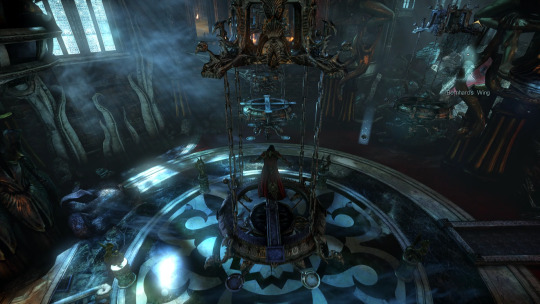
While the item-based puzzle-solving from the first game has been removed, Lords of Shadow 2 introduces numerous intricate climbing sequences. Players must carefully observe their surroundings and strategically plan their climbing and jumping routes to reach their destinations.
Stealth:

Several mandatory stealth sections are woven into the main storyline. In these segments, direct combat is impossible, and detection by enemies results in swift death. Players must utilize bats to distract foes and transform into a rat to traverse narrow passages, ultimately sneaking behind enemies to possess them and use their bodies to activate door switches.
Two of the game’s bosses also require mandatory stealth sequences prior to their boss fights, where players must evade their pursuit and reach a specific location to initiate the battle.
Compared to dedicated stealth games, the stealth mechanics in Lords of Shadow 2 feel uninspired and simplistic, lacking integration with the game’s core gameplay loop. Removing these sections could have potentially enhanced the overall experience.
3. Progression and Collectibles
Move Unlocks and Weapon Mastery:
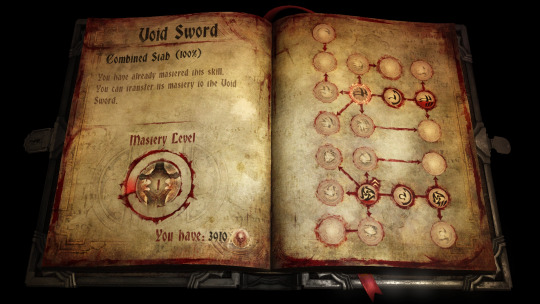
Each of the three main weapons possesses its own distinct and comprehensive move list. Defeating enemies grants experience points, which can be spent to unlock new moves. Repeatedly using the same move in combat accumulates its mastery level. Reaching 100% mastery for a move signifies its complete proficiency. Mastering multiple moves contributes to the weapon’s overall Mastery Level, which can ultimately be raised to level 3.
Health and Mana Capacity Upgrades:
Life Gems, Void Gems, and Chaos Gems are scattered throughout the game’s levels. Collecting five gems of the same type increases the corresponding stat’s maximum capacity. There are 30 gems of each type to be found.
Collectibles and Hidden Content:
Beyond the three types of gems, the game world also contains numerous Knights’ Diaries and City’s Memories, providing players with insights into the game’s lore.
4. Unique Flavors

Lords of Shadow 2 inherits the lavish dark gothic art style prevalent in the Vampire Castle sections of its predecessor, transforming these aesthetics into freely explorable 3D Metroidvania environments. If one were to disregard the game’s other half, the modern city sections, this would be, in my mind, the perfect 3D successor to classic 2D Castlevania titles. Players, much like in Symphony of the Night, embody a vampire protagonist, freely exploring Dracula’s Castle and possessing the ability to transform into a bat or mist.
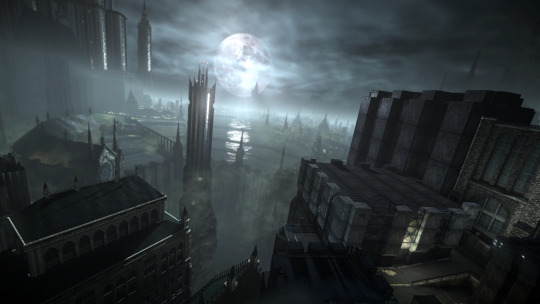
The modern city sections, comprising the other half of the game, also offer a unique flavor. Players explore a metropolis that blends medieval and contemporary architecture. Built upon the ruins of Dracula’s Castle, the city features numerous dark gothic structures, creating an atmosphere reminiscent of Arkham City from Batman: Arkham City. The experience of playing as an ancient vampire battling demons and cyberpunk-style mechs in a futuristic city is, to my knowledge, a unique blend on Steam.
5. Story and Lore
Main Story:
The narrative of Lords of Shadow 2 directly follows the events of Lords of Shadow and Mirror of Fate. The story begins with Dracula’s awakening in the modern city, a direct continuation of the first Lords of Shadow’s ending. Zobek informs Dracula that Satan, defeated in the previous game, is poised for another invasion. To avoid enslavement by Satan, Dracula must seek out three of Satan’s acolytes to prevent his return.
The story unfolds through two interconnected plotlines. The first sees Dracula venturing through the illusory Dracula’s Castle to regain his lost powers and collect the fragments of the Mirror of Fate. The second plotline follows Dracula, guided by Zobek, as he investigates the identities of Satan’s three acolytes and attempts to thwart their schemes in the real-world Castlevania City.
First Plotline: Upon awakening from his slumber, Dracula has lost all his power. Consequently, players repeatedly enter illusions of Dracula’s Castle, formed from Dracula’s memories of the past, to rediscover and reclaim lost abilities such as the Void Sword and Chaos Claws. Within this illusory castle, Dracula encounters Marie, his wife from the first Lords of Shadow, and Trevor, one of the protagonists from Mirror of Fate, appearing as a child. Guided by Marie and Trevor, Dracula recovers his full power and gathers all the fragments of the Mirror of Fate, ultimately confronting and defeating his inner evil, reconciling with his past, and achieving spiritual redemption. I consider this plotline to be the stronger aspect of the game’s narrative, effectively tying together the events of Lords of Shadow and Mirror of Fate.
Second Plotline: Dracula discovers that Satan’s three acolytes have long been lurking within human society, corrupting humanity through demonic influence. Early in the game’s narrative, one of Satan’s acolytes develops a virus capable of transforming humans into demons, which is then unleashed upon the city. Subsequently, the majority of the city’s population transforms into zombie-like demons. The protagonist gradually uncovers the real-world identities of the three Satan’s acolytes, eventually leading to a confrontation with and defeat of Zobek and Satan. I found this plotline to be significantly weaker: “Firstly, the rapid transformation of the entire city into a zombie-infested wasteland reminiscent of Raccoon City in Resident Evil 2, occurring so early in the game, deprives us of seeing Dracula, a centuries-old vampire, confronting the shock of the modern world. Secondly, while the three Satan’s acolytes are given human identities – a pharmaceutical researcher, an arms dealer, and a false priest – the game fails to illustrate how they leverage their societal positions to corrupt humanity. Thirdly, when Dracula captures the pharmaceutical researcher in an attempt to glean information about the first acolyte, she abruptly transforms into the first acolyte without any prior narrative foreshadowing. Fourthly, Dracula’s encounter with the second acolyte sees him rendered helpless by lightning attacks. Despite being portrayed as powerful, this acolyte is defeated once his three possessed statues are destroyed, denying players a direct boss fight against his true form. Fifthly, the third acolyte is narratively built up as being even more powerful than the previous two, yet he is immediately killed by Satan after successfully summoning him, again denying players a boss fight against a seemingly formidable foe. Sixthly, Satan, as the game’s final boss, exerts less presence and threat than even his acolytes. The final boss battle sees him possess Alucard to fight Dracula, and upon Alucard’s defeat, Satan’s true form flees rather than engaging in a decisive battle, only to be killed by Dracula using the Vampire Killer. This ending feels wholly inadequate for a character of Satan’s stature. I had anticipated an epic boss encounter akin to those in the original Lords of Shadow. Furthermore, a significant plot hole arises here: if the Vampire Killer can definitively kill Satan in Lords of Shadow 2, why did Gabriel, wielding the same weapon in the first Lords of Shadow, fail to do so? Moreover, the Vampire Killer is presented as a weapon crafted by humans, so how does it possess the power to permanently kill Satan?”
If the game had solely focused on Dracula’s adventure and self-redemption within Dracula’s Castle, I would have rated the story an 8 out of 10. However, the modern city storyline feels like a poorly executed and incomplete imitation of Resident Evil 2, plagued by illogical and abrupt plot developments.
Character Development and Narrative Depth:
I will evaluate the character development in two parts: the Dracula’s Castle sections and the Castlevania City sections.
Dracula’s Castle Sections:
Dracula’s Castle features the return of several characters from Lords of Shadow and Mirror of Fate, including Marie, Trevor, Alucard, Chupacabra, and the Toy Maker. Deceased characters from the first Lords of Shadow, such as Claudia and the Black Knight, also appear as chess pieces. Carmilla, a boss from the original game, makes a reappearance as a boss in this installment. Agreus, Pan’s brother who aided the protagonist in the first game and ultimately sacrificed himself, also returns as a boss, serving as a poignant reminder of the previous narrative. Across the trilogy, the unwavering support and assistance of Dracula’s wife, Marie, left a lasting impression. Furthermore, Mirror of Fate and Lords of Shadow 2 extensively feature elements related to the Toy Maker – carousels and puppet theaters – with a pre-boss fight puppet show revealing the tragedy of the Toy Maker’s deception and imprisonment within the castle.
Players who have experienced Lords of Shadow, Mirror of Fate, and Lords of Shadow 2 will find that the overarching narrative forms a complete Greek tragedy. Gabriel, a knight of the God’s Brotherhood of Light, embarks on a quest to defeat the three Lords of Shadow to revive his wife, Marie, only to discover that these Lords were the corrupted founders of the Brotherhood he served – the dragon slayer ultimately becoming the dragon. Moreover, the one responsible for his wife’s death was none other than himself, manipulated by Zobek, one of the Lords of Shadow, who was himself a pawn of Satan in his plot to invade the world. Despite saving humanity, Gabriel transforms into the new Prince of Darkness, Dracula, and is hunted by the very Brotherhood he once served, including his own son, Trevor, and grandson, Simon. He inadvertently kills his son, Trevor, and even though he uses his blood to transform Trevor into the vampire Alucard, Alucard ultimately stands against Dracula. Finally, after a millennium, Dracula achieves spiritual self-redemption, reclaiming his humanity and vanquishing Zobek and Satan, ensuring that no other Dark Lord will threaten humanity.
The thematic core of the Lords of Shadow series is Fate: the three Founders of the Brotherhood of Light become the three Lords of Shadow, Gabriel who defeated the Lords of Shadow becomes Dracula, and Gabriel’s son Trevor who was meant to defeat Dracula becomes the very vampire he despises, Alucard. Every hero who once stood in the light ultimately falls to darkness. However, in the ending of Lords of Shadow 2, Dracula shatters the Mirror of Fate, signifying his rejection of predetermined destiny and breaking the cycle of heroes becoming monsters. In this regard, I consider the narrative of the Lords of Shadow series to be an excellent Greek tragedy, with Dracula’s self-redemption in Lords of Shadow 2 providing a fitting conclusion to the saga.
Castlevania City Sections:
As mentioned earlier, the characterization of the three Satan’s acolytes is muddled and lacks sufficient narrative or environmental context to support their backgrounds. In contrast, the original Lords of Shadow effectively established the personalities and backstories of the three Lords of Shadow through environmental storytelling and plot developments leading up to their boss encounters. Therefore, the portrayal of the three primary story bosses in Lords of Shadow 2 represents a significant regression compared to its predecessor.
Later in the game, Dracula encounters Victor, the last descendant of the Belmont family. He wields Gabriel’s primary weapon from Lords of Shadow, the Combat Cross, along with other relics acquired throughout the game. His fighting style is almost identical to that of the player-controlled protagonist in the first Lords of Shadow, leaving a strong impression. I had hoped for more narrative development for this character, perhaps a storyline involving a vampire hunter and a vampire collaborating against Satan. However, Victor dies shortly after his introduction, sacrificing himself for Dracula, a former enemy he had just met, succumbing without resistance to the sword of a statue possessed by one of Satan’s acolytes. I believe that even if the developers intended for the last Belmont to perish, it should have occurred within a more epic narrative context. Victor’s meaningless death trivializes the legacy of Belmonts as playable adventurers in the Castlevania series, making their history feel like a joke. Furthermore, Victor and Dracula’s sudden alliance feels forced and underdeveloped, lacking a believable transition from antagonism to cooperation.
At the end of the game, Zobek’s Lieutenant removes his helmet, revealing his true identity as Alucard. However, there are no prior narrative threads or subtle hints throughout the game to suggest Alucard’s involvement or his disguise as Zobek’s Lieutenant during their interactions with Dracula.
In summary, the Dracula’s Castle storyline, along with the preceding two games, forms a cohesive narrative that aligns with the series’ core theme of Fate. Despite a lack of extensive cutscenes, the character portrayals are memorable. Conversely, the Castlevania City storyline has virtually no connection to the previous Lords of Shadow titles and the primary setting in a modern city feels entirely disconnected from the iconic medieval castle setting of the Castlevania series.
Worldbuilding:
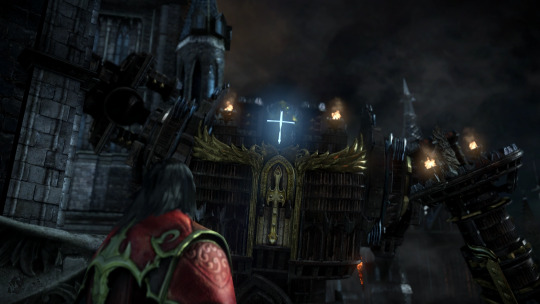
Similar to its predecessor, Lords of Shadow 2 effectively utilizes detailed environments and enemy designs to flesh out the world of the Lords of Shadow series. For instance, the game’s opening sequence depicts Dracula facing an invasion of his castle by the Brotherhood of Light’s forces, mirroring the first Lords of Shadow where the protagonist, Gabriel, was sent by the Brotherhood to defeat the three Lords of Shadow. The roles are reversed, with the protagonist now being the hunted evil. The Brotherhood’s use of Titans to siege Dracula’s castle also echoes the Titan boss battles of the first game.
During the climactic battle against a Paladin of the Brotherhood, the Paladin wields a holy crucifix and recites prayers in Latin, such as “Christus ab omni malo te defendat.” Later, players encounter other Brotherhood enemy types, including priests who also perform magical rituals using Latin incantations. This attention to detail makes the fictional Christian Holy Order of the Brotherhood of Light feel more authentic and believable, enhancing the game’s worldbuilding and immersion.
The opening narrative establishes that Dracula’s Castle has been destroyed and lies in ruins, with Castlevania City being built upon its foundations. Consequently, players will discover locations within Castlevania City that are modern reinterpretations of areas encountered in the illusory Dracula’s Castle. The game also subtly hints at the nature of the Dracula’s Castle that players explore: is it a mere illusion or a tangible place? The narrative suggests that Dracula possesses the ability to manifest his thoughts into reality, with his primary weapons, the Void Sword and Chaos Claws, being physical manifestations of his inner emotions.
6. Visual Experience
Art Style:

Dracula’s Castle in Lords of Shadow 2 heavily draws upon the dark gothic architectural style seen in the Vampire Castle sections of the first Lords of Shadow, featuring ornate carvings, elaborate chandeliers, colossal statues, and gothic spires. Each of the four distinct areas within the castle possesses its own unique characteristics, such as the lava-filled City of the Damned and the ice-covered Overlook Tower.

In contrast, Castlevania City feels like an amalgamation of Arkham City from Batman: Arkham City and Raccoon City from Resident Evil. The city streets are lined with neoclassical-style retro-modern buildings, often topped with gothic medieval roofs and gargoyles. Players engage in combat against zombie-like enemies and cyberpunk-style mechs under the cloak of night. The interiors of buildings, however, often feature modern laboratories and hospitals. I found these modern interior environments to clash with the game’s overarching dark gothic aesthetic, disrupting the sense of immersion.
Design Consistency:
The game’s environments and enemies are divided into several disparate stylistic categories.
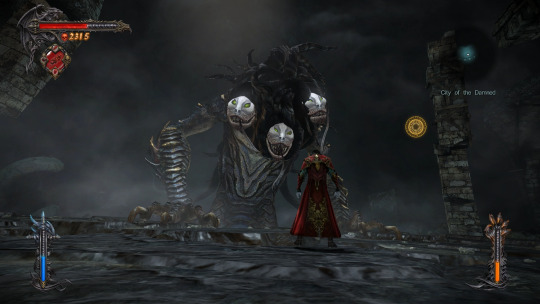
Firstly, Dracula’s Castle is a lavishly detailed dark gothic castle, populated by classic Castlevania monsters like vampires and skeletons, as well as the opposing Knights and Priests. Here, the environment and enemy styles are cohesive and align with my expectations for a 3D Castlevania game.
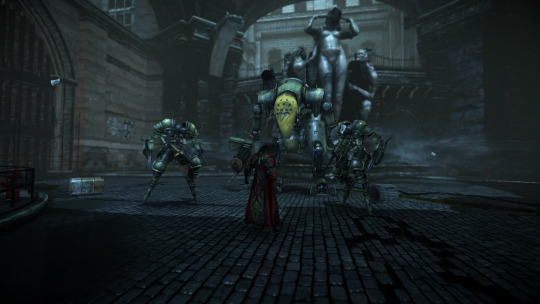
Secondly, the streets and exteriors of buildings in Castlevania City exhibit a dark gothic-infused neoclassical retro-modern architectural style, reminiscent of Arkham City. This style differs significantly from the opulent medieval architecture of Dracula’s Castle, making it feel like two distinct games. The constant transitions between the modern city and the ancient castle feel jarring. Furthermore, the enemies encountered here – zombified humans, demons, and mechs – feel stylistically out of place in a vampire-themed game. The mechs, in particular, have a purely sci-fi aesthetic that lacks any of the dark gothic elements associated with the Castlevania series, feeling like forced inclusions from another game.
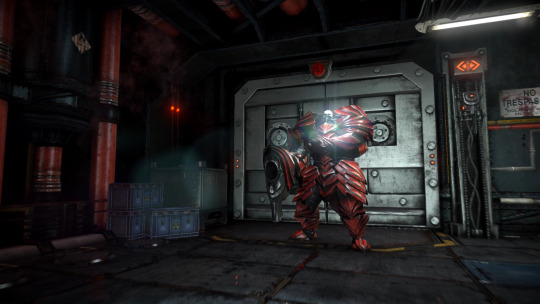
Thirdly, the interiors of buildings in Castlevania City feature numerous modern laboratories and underground passages. These indoor environments lack any details that evoke the dark gothic art style of the Castlevania series, instead resembling generic laboratories from other modern-themed games. A common enemy type in these areas is a heavily armored soldier with firearms, who cannot be attacked directly, forcing stealth gameplay. This segment of the game, with its environments and enemies, feels more like a near-future stealth game than a Castlevania title.
Therefore, the game suffers significantly from a lack of design consistency.
Detail and Impact:
The level of graphical detail in Lords of Shadow 2 is impressive, with intricate environmental details and character costume designs that hold up even in 2025. It even surpasses the visual fidelity of recent vampire-themed titles like V Rising. The opening Titan boss fight delivers a strong sense of epic scale, and the towering, ornate statues and architecture encountered during outdoor exploration also contribute to this feeling. However, regrettably, the game’s boss battles lack the awe-inspiring and epic intensity of those in the original Lords of Shadow.
7. Controls and UI
Control Convenience:
The control scheme in Lords of Shadow 2 largely inherits from its predecessor but reduces the frequency and difficulty of QTEs. The introduction of multi-directional dashing with the LT button replaces the acceleration run from the first game, which was prone to misinputs. The game also removes the need for sprint-jumps or hook swings combined with jumps to reach distant platforms in climbing and jumping sections, eliminating frustrating jump failures due to control errors or mistimed inputs.
UI Interface:
Lords of Shadow 2 retains the medieval book-style UI from the first game, contributing to the sense of immersion. However, as a 3D Metroidvania title, it only features a mini-map for the current area, lacking a comprehensive map of the entire world. This often led to disorientation when revisiting previous levels to find hidden locations, forcing me to rely on memorizing the entrances and exits of different areas. The absence of a full map makes the late-game exploration for secrets feel akin to another 3D Metroidvania game without a map – Dark Souls – where players are forced to learn the layout through repeated exploration.
8. Difficulty and Challenge
Difficulty Settings:
The game’s difficulty can be broken down into several aspects:
3D Metroidvania Exploration and Puzzles: The exploration in Lords of Shadow 2 blends elements of 3D Zelda and Castlevania: Symphony of the Night. Players will encounter numerous areas that are inaccessible with their current abilities or hidden from view. The lack of a full map and the inability to mark locations further complicate navigation, forcing players to rely on memory. The interconnected nature of many sub-areas without a comprehensive map often leads to confusion and difficulty in determining the direction of unexplored regions.
The game removes the item-based mini-game puzzles from its predecessor, replacing them with platforming puzzles. Players must observe climbable and jumpable surfaces and strategically plan their routes to reach their destinations. The removal of environmental traps also means that platforming sections are less punishing, requiring only careful observation and route planning.
Regular Combat: Compared to the first Lords of Shadow, the combat difficulty in Lords of Shadow 2 is somewhat reduced. Notably, the mechanic of initiating executions by grabbing enemies has been removed. In the previous game, executions would yield orbs for mana recovery, whereas in this installment, orbs are only dropped by defeating enemies without triggering an execution.
As mentioned earlier, the introduction of heavily armored enemies that require their armor to be broken before taking frontal damage, endlessly respawning enemies, and summoning-type enemies significantly increases the complexity and challenge of combat encounters.
To assist players struggling with combat, the game introduces several consumable items that can be used in battle, such as items that instantly restore full health, grant temporary unlimited mana, temporarily slow down time, and temporarily unlock all weapon moves. These items can be replenished at the shop, offering an option for players to alleviate combat difficulty.
Boss Battles: On normal difficulty, boss health and damage output are relatively low. Boss AOE attacks are infrequent and telegraphed with clear visual cues, allowing most players to defeat bosses on their first attempt without the need for repeated reloads.
Challenge:
The challenge in Lords of Shadow 2 primarily stems from two areas:
First, discovering hidden areas within the environments and acquiring all collectibles. Many collectibles are placed in obscure locations or require finding specific jumping paths to reach.
Second, completing the challenge modes. Collecting certain in-game items unlocks challenge modes that task players with defeating specific enemies under restrictive conditions, such as defeating heavily armored enemies without using the armor-breaking Chaos Claws.
9. Conclusion and Score
Overall Assessment:

Castlevania: Lords of Shadow 2 is an action-adventure game that attempts to blend 3D Metroidvania exploration with God of War-like hack and slash combat. The game marks a return to the Metroidvania exploration mechanics of the Castlevania series, with players utilizing abilities to access new areas and uncover hidden collectibles across two distinct large maps, one of which, Dracula’s Castle, feels like a 3D reimagining of classic Castlevania environments. However, the mandatory stealth sections feel tedious, and the inclusion of modern city and mech elements clashes with the traditional medieval aesthetic of the Castlevania series. These flaws prevent what could have been a new pinnacle for the franchise from achieving its full potential, ultimately making it a somewhat disappointing final major entry. Nevertheless, if one can overlook the jarring modern city elements and forced stealth sections, Castlevania: Lords of Shadow 2 remains a visually impressive and fluidly combat-driven vampire-themed game in 2025. It also stands as one of the few titles outside of the Darksiders, Batman: Arkham, and STAR WARS Jedi series to offer a 3D Metroidvania-style open-world exploration experience.
Pros:
Return of Castlevania series’ Metroidvania exploration in a 3D open-world format
Excellent combat experience and hit feedback
Gorgeous dark gothic art style and environmental detail
Cons:
Stylistic clash between the Vampire Castle and modern city maps
Tedious mandatory stealth elements
Out-of-place mech-type enemies
Abrupt and underdeveloped plot
Who Should Play:
Die-hard fans of the Castlevania series, enthusiasts of Metroidvania games.
Score:
Gameplay: 7/10
Story: 7/10
Graphics: 9/10
Controls: 8/10
Overall: 7/10
2 notes
·
View notes
Text
STALKER 2: Heart of Chornobyl Review in Progress
So far, severe bugs have been adding the wrong kind of friction to this refreshingly brutal single-player FPS.

A certain kind of friction can go a long way in creating a challenging and punishing game that’s also gripping. When developers leave you to figure things out for yourself amid dangerous enemies that can kill you on a moment’s notice, rarely giving you an easy way out of a mess, it becomes clear that the survival instincts embedded in the STALKER series are very much alive in the long-awaited STALKER 2: Heart of Chornobyl. Then there’s the type of friction that prevents you from engaging with it in earnest, like poor technical performance, bugs that are sometimes hilarious but at others game-breaking, or nonsensical enemy behavior. STALKER 2 has both kinds of friction in equal measure. It just can’t stop getting in its own way, but for all that’s working against it, there’s an underlying greatness that surfaces every now and then.
STALKER 2 is a massive game; as of this writing, I’m about 20 hours into my playthrough and still have so much left to do in The Zone in both the main story questline and in side missions that I’m having to squint to see a light at the end of the tunnel. Due to the review copy coming in just a week before launch and a progress-halting bug in the main mission (which cost me a day of playtime and required me to reload a previous save that made me lose about four hours of progress in order to avoid it), I haven’t been able to finish it in time to give you a final verdict at launch. And for a series like STALKER, where the resolutions to the story’s mysteries are inherent to how it’s earned its cult following, seeing it to the end is of utmost importance, regardless of the roadblocks I have to truck through to get there.
STALKER 2: Heart of Chornobyl - 28 Minutes of 4K PC Gameplay
28:34
Autoplay setting: OnSTALKER 2: Heart of Chornobyl - 28 Minutes of 4K PC Gameplay
3 notes
·
View notes
Text
5. Turnip Boy Robs a Bank
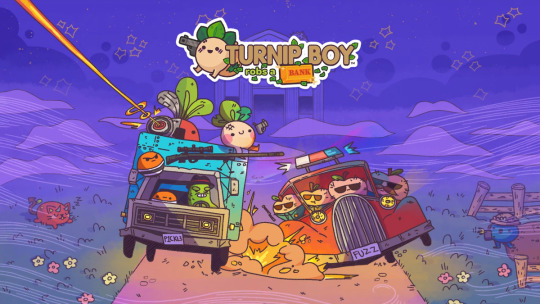
Release: 2024, PC/Switch/Xbox One Beaten: January 27th, Xbox Series S (Game Pass) Playtime: 6h 49m (100%)
Turnip Boy Robs a Bank, the sequel to Turnip Boy Commits Tax Evasion, is a strange game in many ways. Aesthetically and thematically it matches the vibe of the first game, albeit with humor and writing that's just a little bit tighter. Mechanically, it is considerably different from its predecessor, focusing on a run-based system that relies on a bit of randomization. It pulls off both its tone and its gameplay, for the most part, very well. This review will be long, and Tumblr is letting me implement "read more"s again, so I'm using one here.
I want to hone in on that element of randomness though, because I made the mistake of going into this game expecting it to be constructed like a roguelike. The way the game is actually set up is that there's a consistent map with mostly consistent enemy spawns, but certain locations on the map ("elevators") lead to pre-constructed rooms that will be rolled randomly each time you begin a run anew. These "elevator" rooms seem to be basically a few different levels whose layouts are mostly not randomly generated; the only major element of randomness in terms of navigation is whether the consistently-placed elevator door is going to teleport you to room A or room B. The weapons that drop in each run are an actual element of randomization that feels more akin to a roguelike, but the world itself does not feel random.
So what that leaves is a gameplay loop where you enter the bank on a timer (which can be expanded), and make choices between progressing through the non-changing portions of the bank--consisting of picking up side quests, discovering obstacles which you need to get an item for to progress through in the next run, memorizing the layout for easier navigation, defeating bosses--and entering the randomized elevator rooms that appear in that run. The consistent thing in every run is trying to snag money, which can be done in multiple ways and is pretty fun to minmax. The money can then be used on upgrades and story-progressing items.
I actually ended up liking this core gameplay loop a lot. I found that as time went on, I was able to be more efficient with my time, which felt pretty satisfying. It's overall a pretty well-designed core experience that doesn't get tiring or boring and gives you a lot of things to do during its runtime. It's not designed to be an infinitely replayable game like most roguelikes, but I think it's probably better for that.
There were mainly two things I didn't like. The first was actually a pretty minor gripe, and it was that I went through about 2 hours of gameplay continually checking for a side quest NPC but never getting the elevator room that would take me to interact with them. I couldn't remember what that room looked like, and so I spent a ton of time checking every room that spawned in case it was the one that would house that NPC. It ended up being the final thing I did in the game, and I did spend a good 20 minutes exclusively trying to get that one room to spawn. The reason this is still a "minor" gripe is because, for the most part, I had other things I was completing during the act of looking for this NPC, so I didn't feel like my time was totally wasted. But still, the randomness can sometimes be to the game's detriment.
The other thing is a major gripe, and it's the ending of the game. The only spoilers I'll be providing here are spoilers about the mechanics of the end game segment and why I didn't like it; feel free to skip to the last paragraph if you want to avoid that.
The "story" ending itself was fine. Pretty good even, I'd say. Gameplay-wise, it fucking sucks. You're expected to do a boss rush, which in the case of this game, consists of navigating through four corners of the map and defeating each boss located there. It's not as simple as "fight boss 1, fight boss 2." You have to actually navigate through rooms filled with enemies and obstacles to get to each of those boss fights. On its own, that boss rush isn't that bad, and actually becomes kind of fun as it tests your knowledge of the map layout, a skill you've honed naturally throughout normal gameplay.
Unfortunately, the boss rush is followed by a chase sequence in a new but equally large version of the bank that again asks you to navigate to each of the four corners of the map. The chase sequence involves attacks that basically take out a third of your health if you get hit by them, alongside tanky, new enemies and strange terrain. Again, on its own, this is fine. But if you die during this phase, you have to redo the boss rush again on the next run, meaning you need to redo a reasonably difficult thing that takes about ten minutes before every attempt at the final boss chase sequence. It's weirdly punishing in a way that feels deliberate and I think it was a pretty bad choice.
But like, okay, I still ended up really liking my time with the game. I was salty about the end game for a bit, but after some rumination, I don't think it ruins the experience. I also have a feeling that ending is going to get patched to be easier at some point in the future, because it seems like a pretty obvious misstep. All in all, yes, I'd recommend Turnip Boy Robs a Bank if you're a fan of the first game. If you've never played the first game, I think they're both worth checking out, but this one is a vastly superior game.
#MT24 January#media thread#media thread 2024#2024 games#games writing#also fun fact#the original turnip boy was my 5th game of 2023#now this is my 5th of 2024#Series S#Game Pass
4 notes
·
View notes
Text
Understanding the Cavapoo: A Comprehensive Guide to the Adorable Doodle

Introduction
Cavapoos are among the most beloved designer dog breeds, capturing hearts with their charming looks and playful personalities. This hybrid breed, a delightful mix between the Cavalier King Charles Spaniel and the Poodle, boasts a unique combination of characteristics that make them ideal companions for families and individuals alike. In this guide, we’ll explore the essential traits, care needs, and fascinating history of the Cavapoo, providing you with all the information you need to understand this lovable breed.
1. Cavapoo Characteristics
1.1 Appearance
Cavapoos typically have a soft, wavy coat that can vary in color, including cream, apricot, chocolate, and black. Their size can range from toy to miniature, depending on whether the Poodle parent is a Toy or Miniature Poodle. Adult Cavapoos usually weigh between 10 to 25 pounds and stand around 10 to 15 inches tall at the shoulder.
1.2 Temperament
Cavapoos are known for their friendly and affectionate nature. They are social dogs that thrive on companionship, making them great family pets. Their playful demeanor and gentle temperament make them excellent with children and other pets. Cavapoos are intelligent and eager to please, which makes training relatively easy, provided you use positive reinforcement techniques.
1.3 Energy Level
While Cavapoos enjoy playtime and daily walks, they are not excessively high-energy dogs. They require moderate exercise—about 30 minutes to an hour each day—to keep them healthy and happy. A mix of walks, play sessions, and mental stimulation through interactive toys will suffice.
2. Health Considerations
Cavapoos can inherit health issues from either parent breed. Some common concerns include:
Hip Dysplasia: A genetic condition that can affect mobility.
Ear Infections: Due to their floppy ears, regular cleaning is essential to prevent infections.
Eye Issues: Such as cataracts and progressive retinal atrophy.
3. Grooming Needs
Cavapoos typically have a low-shedding coat, which is a significant advantage for allergy sufferers. However, their coats require regular grooming to prevent matting and tangling. Here are some grooming tips:
Brushing: Brush their coat at least two to three times a week.
Bathing: Bathe them every four to six weeks or as needed.
Trimming: Schedule professional grooming every few months to maintain their coat length and prevent matting.
4. Training and Socialization
Cavapoos are intelligent and responsive, making them relatively easy to train. Early socialization is crucial to ensure they grow up to be well-rounded dogs. Here are some training tips:
Start Early: Begin training and socializing your Cavapoo as soon as you bring them home.
Positive Reinforcement: Use treats and praise to encourage desired behaviors.
Consistency: Be consistent with commands and routines to reinforce learning.
5. Conclusion
The Cavapoo is a wonderful breed that combines the best traits of the Cavalier King Charles Spaniel and the Poodle. Their friendly disposition, intelligence, and moderate exercise needs make them an ideal companion for families and individuals alike. If you’re considering adding a Cavapoo to your family, understanding their characteristics and care requirements is essential for providing a happy and healthy life for your new furry friend.
Call to Action
If you’re interested in adopting a Cavapoo or learning more about responsible breeding practices, feel free to explore our website or contact us for more information. We are dedicated to raising healthy and happy Cavapoo puppies that will bring joy to their new families.
0 notes
Text
Getting started in TotK
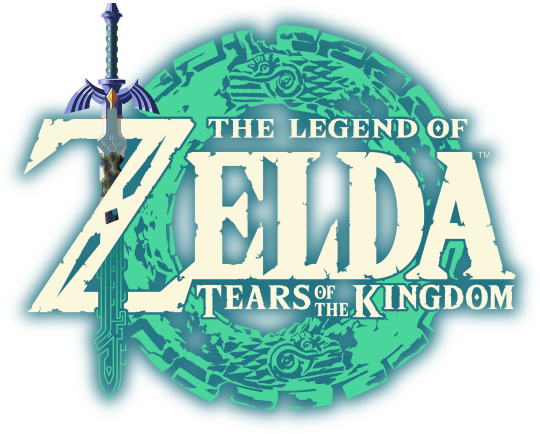
Hyrule awaits, and it's bigger than ever before. The Legend of Zelda: Tears of the Kingdom is a massive open world game, so much so that it can be a little overwhelming at first. There are so many places where players can go, and there are so many tempting routes to take.
After having finished the game and having 145 hours of playtime, I decided to share some tips, tricks, and recommendations on getting started in the post-Upheaval Hyrule.
Get used to your new abilities on the Great Sky Island
The Great Sky Island is where you start your adventure, and you get all four abilities —Ultrahand, Fuse, Ascend, and Recall — over the course of the tutorial area. The game teaches you how to use the abilities and a general idea on how they interact with the world via Shrines and talking with the Constructs.
A neat trick from me is to combine the power of Ultrahand and Recall to make an elevator. First, use Ultrahand to lift a large piece of wood (or anything that can be used as a platform) in the air for several seconds and then put it back down. Then you stand on the platform and use Recall on it. Then watch as the platform floats for several seconds, and you have successfully made an elevator of sorts that allows you to bypass a lot of puzzles in the game and allows you to have a much easier time collecting Blessings of Light. Some examples of the elevator trick below.
https://www.youtube.com/shorts/IDCOZCCd_eA by MysticSlime
https://www.youtube.com/shorts/5gn2gb_A6Xc by Hardpelicn
Where to go first in TotK
When you first get to Hyrule, you can basically go wherever you want. But I would recommend going to Lookout Landing to progress the main story so you can get the Paraglider and your first Skyview Tower.
A personal recommendation from me is to make some stamina replenishing foods or potions so you can glide into Hyrule Castle from the Skyview Tower. The reason for doing this is because Hyrule Castle has a lot of powerful endgame-tier gears like the Royal Knight Weaponry, the Champion’s Tunic, the Twilight Bow and the Hylian Shield, the strongest shield in the whole game. There is also a Shrine there, which you can use to teleport back to the Castle anytime you want for easy access.
A guide on getting the Hylian Shield by By Austin John:
youtube
Get a Horse
While Tears of the Kingdom allows you to make some elaborate Zonai machines to get you somewhere fast and encourages outlandish creativity, it is pretty hard to get the resources needed to make those machines when you are in the early game. Therefore, I recommend you get a horse instead. They are boring compared to the Zonai contraptions, but damn they are very practical. You can get a horse as early as Central Hyrule. Capturing a horse requires tou to sneak up on them and press 'A' when you're close enough to the horse. When you’re on top of the horse, give them some pats with the 'L' button, and then you're off. Horses make for a safe way of getting around too, as they naturally follow the roads of Hyrule.
Alternatively, if you have a save file of Breath of the Wild in your Nintendo Switch, Tears of the Kingdom will carryover the horses you have tamed in BotW. All you have to do to be able to use them is to go to a stable and talk to the vendor. They will check your history and make it so that you can use the horses you have tamed in BotW.
Get yourself rich fast
You started the game with zero Rupees to your name. So here are tips on making yourself rich in the early game so you can buy some good armor or materials.
1. Sell some cooked food
One of the best ways to accumulate a lot of Rupees is to get busy with a cooking pot. Cooked meals fetch a good price for merchants and the higher the quality of the meals, the more profit they’ll net you. It is recommended that you use high quality meats like bird thighs, prime meat, raw whole bird and especially the gourmet meat because they are the most valuable food stuff to use for cooking meals.
2. Mine some precious ores and sell them
In Hyrule, caves are full of mineral veins that respawn a few hours after you mine them. By mining these veins, you can get rubies, opals, sapphires, topazes, and even diamonds. These precious stones fetch a high price in Hyrule market, with one diamond worth 500 rupees.

3. Hunt Blupees
Blupees are blue rabbit-like spirits that are normally found outside of caves. When shot, they will drop a lot of Rupees and run away, usually into the caves. This makes them a good way to get some Rupees fast and a nice indicator of cave locations.
That is all from me. Hope you have good time playing the Legend of Zelda: Tears of the Kingdom
0 notes
Text
things that make 3 the best game:
lots of cool features added. the crank-a-kai system in 3 is better than in 1 and 2 (though also the darts suck), the new yo-kai searching minigame thingie is neat, the yo-kai vacuum cleaner is nice and the yo-kai drill and yo-kai blaster add unique mechanics (the drill leads to neat secrets), i could probably go on.
all of the new characters are great. as is to be expected nate's bbq classmates/friends n hailey's classmates are pretty underdeveloped but they seem neat from what we see of them. and of course, hailey n buck are the stars of the show here. they're both great n make both stories equally fun. usapyon's also great, i KNOW he debuted in blasters but his personality is extremely different there- the weakest of the new characters are probably blunder n folly since they basically don't do anything for the whole game except inexplicably act like they're plot important when they're not but even they can be neat n there's funni comedy with them at least.
blasters t is fun. it's hell but it's fun.
the story's great too. there being two different stories for most of the game is a really interesting idea, though it can also be annoying if you want to progress one story but can't because you need some fancy that! issue you get in hailey's story as nate or something dumb like that. why's all the story linking hailey doing things n then getting stuff done as nate i only just realized that what the fuck. anyways.
there's soooooo much content. both in the main game and the post-game. the main game alone took me like, a week to complete, whereas my playthroughs of 1 and 2 take like, four days at most (2 has added time from grinding for dame dedtime so ignoring that). and i'm STILL going through the post-game. there's so many post-game quests and other fun things you can do, like going to bbq as hailey (which is useless. she can't go on the raft or do zombie night or anything. she's limited in things she can do in bbq but nate can do everything in springdale) n also just the stuff you'd expect from yo-kai watch's post-game.
did i mention that hailey n buck are amazing n that i love them. best yo-kai watch characters apart from jibanyan.
oh also nate, hailey n buck being besties is amazing. nate getting friends who can also see yo-kai n who aren't his dead grandpa is great good for him he deserves it.
i can't decide if the length is good or bad. i guess i already mentioned how long it is. i have like 100 hours of playtime and i've only finished two blasters t dungeons what will my playtime be like once i finish blasters t and the post-game and everything-
nate, hailey n buck being besties is so great that it gets to be a bullet point twice over. they're so fucking stupid together i love them. there is a single braincell n nate n buck share it n hailey never gets it.
oh also hailey high-key has adhd n autism i made a whole essay about that. the points were like. 1. her interests are v intense (like hyperfixations/special interests). 2. she's v hyper seemingly both physically n mentally (the h in adhd stands for hyperactivity so). n 3. she is seemingly not very great at socializing but also idk how much of that's actually canon n how much of it is me projecting sdklfjklfsdjfds-
i mean i feel like you could make some sort of argument for most yo-kai watch characters being neurodivergent in some shape, way or form. though i'm saying this as a neurodivergent person who ends up headcanoning like every character i like as neurodivergent n has no idea how neurotypicals work so- i high-key accidentally made katie neurodivergent in my rewrite ngl i've just accepted it at this point.
#puppy rambles#yo-kai watch#yw3#how much of this is a shitpost vs not? idk you tell me#if you couldn't tell i like hailey n buck slkdfjkdflsjfkljfds#wish there was more of nate hailey n buck being dumbasses together in the post-game#four or smth chapters of it isn't enough#the post-game's dumbassery between them is just like. during the tower of zenlightenment#n that's really only during the first time you do it seemingly-#i tried it a second time n there was basically no dialogue#it was really boring-#maybe there's just less dialogue if you play as nate fsdjfdkjsflkfsjd
6 notes
·
View notes
Text

Our NaNoRenO2022 BL project, start;again, is now released on both Steam and Itchio!
Awakened in an unfamiliar location, four strangers are forced into a life-or-death situation they must escape within two hours. How did they get there? Who is behind it all? Who can be trusted? …And why does it feel as though some of these strangers may not be strangers after all? Play as Sebastian in this BL/yaoi visual novel as you uncover the truth—no matter the cost.
⏱A branching story: Over 35,000 words (2-3 hours playtime), many endings both good and bad, and a flowchart where you can keep track of your progress through start;again. ⏱Captivating visuals: Original illustrations by 瞬, Tomomochi and Lids will pull you right into the mystery. ⏱Minigames: start;again features a variety of minigames throughout its winding story. ⏱Romance, mystery and comedy: Is there really room for all of these in a death game…?
Grab it on Steam here or Itch.io here!
15 notes
·
View notes
Text
Notable 2020 Video Game Soundtracks That Can Be Enjoyed As Standalone Experiences
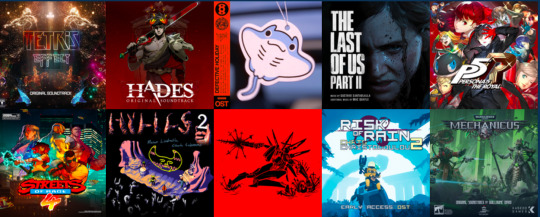
Video Game Music is gaining recognition, with many soundtracks receiving vinyl pressings, orchestral concert reviews, and an increasing presence on music streaming platforms such as bandcamp and Spotify. We’re also witnessing the uprise of indie video game development teams where games are being made by the sort of passionate type of game designer that takes soundtracks seriously. Soundtracks by small teams of developers such as Celeste, Undertale, Disco Elysium, Hollow Knight, RuneScape, and Lisa: The Joyful are titles with soundtracks that easily stand up against the likes of bigger budget productions made by reliable sources of video game music like Square-Enix and Nintendo.
2020 is no exception in terms of having one of the biggest budget soundtracks around with Final Fantasy 7 Remake, which builds upon a legacy of industry-standard-creating soundtrack work. Taken as a whole, Final Fantasy 7 Remake’s soundtrack is clocking in at over 8 and half hours of music. The soundtrack has three composers with the Beethoven of video game music, Nobuo Uematsu, most notably coming out of retirement to get the job done. Here are some other amazing 2020 video game soundtracks more conducive for standalone background listening:
TETRIS EFFECT by HYDELIC

Genres: EDM, Ambient Pop and straight up Ambient
Describing this album makes me feel like I’m some sort of burnt out fanciful raver, head permanently lodged in the clouds. The level of giddy technicolor enthusiasm rivals that of Icelandic Sigur Ros frontman Jonsi, but if he wanted to keep his post-rock firmly planted in the outdoor music festival on Mars territory. Despite the album’s notable two hours runtime, each and every song feels like its own uniquely crafted composition, no repetitive motifs or nostalgia-baiting.
There is unfortunately still a Tetris movie in some sort of shaggy state of development in Hollywood right now. The movie is being billed as a dull biopic about the creator of the Tetris game. Whereas listening to Tetris Effect you imagine a Tetris movie directed by someone more fitting like the Wakowskis. Tetris Effect’s opening song “Connected (Yours Forever)” is a bonafide vocal pop song, like a more sugary CVRCHES-style cooing of the lyrics:
“I’m Yours Forever
There is No End in Sights For Us,
Nothing Can Measure the Kind of Strength Inside Our Hearts,
It’s all connected we’re all together in this life, don’t you forget it
We’re all connected in this”
Try your best not to imagine a cast of Hollywood’s most beautiful plucky orphan mutant misfit youths using the power of Tetris to heal a broken and dying planet!
Notable Track: Next Chapter
---------
HADES by DARREN KORB

Genres: Progressive Metal, Folktronica, Folk Metal, Dimotika, Greek Folk Music
Darren Korb has become one of the most notable video game composers of the past decade. Korb, an integral member of the Supergiant family, continues to outdo himself with each and every soundtrack. Bastion and Transistor originally found Korb creating a niche for himself with downtempo folk-infused electronic soundscapes and even some vocal pop with collaborator Ashley Barrett. Hades is an altogether different beast for Korb, who much like the developers of Hades, have found themselves at the height of their powers.
Korb also contributes vocals on this album, and I can say without hesitation that these are some of the nicest vocals I’ve ever heard from a video game music designer, because video game musicians are bonafide musicians.The album clocks in at two and half hours and separate from its game is still an absolute thrill ride.
Notable Track: In The Blood
---------
DEFECTIVE HOLIDAY by MECHATOK

Genres: Ambient Trance, Balearic Beat, Progressive Electronic, Nature Recordings, Spoken Word, New Age
One glance at the album artwork is all it took for me to know that I must listen to this album. Defective Holiday is an indie walking simulator that is explicit about its intentions: a lightly interactive one hour experience. This soundtrack clocks in at only 31 minutes and it is purely the most conventional album in terms of length.
Last week in late November, Mechatok announced a collaboration with one of the leading zoomer Swedish cloud rap mavericks Bladee, the cofounder of the Drain Gang. Last month gives a pretty clear picture of what kind of circles Mechatok is floating in on. Highly online gonzo vaporwave maestro James Ferraro is another apparent influence on this soundtrack, especially regarding the way the sinister mundane dialogue is woven into the soundscape. There’s one particular track on the Defective Holiday OST, “Rescue Shot Buibo”, that is adorned with standard trap-style drum fills that give the album a shot of energy before wandering back off into the haze. This soundtrack and video game is all about the pure vibe and aesthetic nature that are currently trending in these extremely stressful times. In a time where all of our holidays were defective from the very start, I think the casual walking simulator will remain a genre high in demand. I have a feeling we’re going to hear a lot more from this empathetic young German.
Notable Track: Valley
---------
Last of Us II by Gustavo Santaolalla, Mac Quayle (and Ashley Johnson)
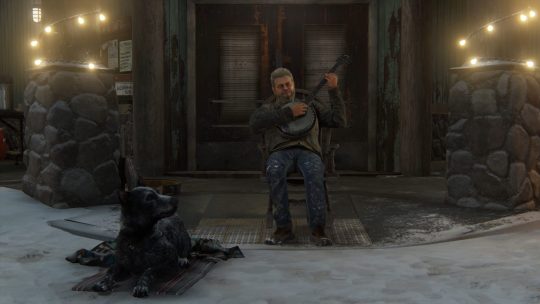
Genres: Ambient, Cinematic Classical, Dark Ambient, Spanish Folk Music
L
The Last Of Us is a horror game where the music itself is arguably playing a critical character role, which can only be expected billing two titans of audio visual soundtracks. Of course Academy Award winner Santaolalla knows his way around a soundtrack. Wielding a resume of astonishing versatility in various TV and film projects, he might have found his higher calling in not only video games but in the horror music canon. Last of Us is an extremely emotional series, and with the wrong soundtrack, the experience could become insufferably bleak. The occasional splashes of color and light are what make this soundtrack so unsettling and eerie. Not since Silent Hill 2’s Akira Yamaoka has there been such an effective standalone horror video game soundtrack experience. No wonder Gustavo Santaolalla is one of the only video game composers integral enough to the game to warrant a cameo banjo-playing character model based off of him.
As if having one major composer from prestigious TV and movies wasn’t enough, Mac Quayle, composer of the whole Mr. Robot series, contrasts against Santaolalla’s acoustic contributions. The soundtrack itself is sequenced in a way that switches between the two composers. “The Cycle of Violence” composed by Quayle, a track that more than lives up to its name, is immediately followed by Santaolalla’s somber “Reclaimed Memories.” This dance between violence and heart is what the Last of Us excels at as a franchise, and that is why this soundtrack is an effective stand-alone experience.
The only disappointing part of the soundtrack is that Ashley Johnson, voice actor of Ellie’ three songs, is not included in the game’s official tracklist. Ellie’s “Take On Me” a-ha and “Future Days” Pearl Jam covers have made a little history by being the most powerful songs sung by a video game character. When Ellie sings and plays on her guitar they aren’t some little Easter egg idling moments to provide levity for this heavy revenge horror story. These songs are used to make some of the strongest character development choices made by a video game character seen in recent years. Ellie is joining a small club of singing video game characters alongside Parapa the Rapper and maybe the cast of obscure Atlus title Rhapsody: Musical Adventure.
Notable Track: Unbroken
---------
Persona 5 Royal Straight Flush Edition by Shoji Meguro

Genre: Acid Jazz, Alternative Rock, Alternative Metal, Lounge, Jazz-Funk
This is one of those soundtracks that, much like Nobuo Uematsu’s work in Final Fantasy, is really the heart and soul of the entire Persona franchise (and his work in the adjacent Shin Megami Tensei universe is equally as noteworthy). Persona 5 Royal finds Meguro making his most complete, funky, and otherworldly opus that sounds like no one else in the biz.
You will find many people online scouring message boards, subreddits, bandcamp features, and Yahoo Answers looking for more music like Persona 5. Outside of Metal Gear Solid: Snake Eater, how many other games are packed to the brim with truly foxy songs!? Persona 5 could not predict how badly the title “Throw Away Your Mask” would age, despite the game being more than ahead of its time with the majority of NPCs wearing PPE. Be a good Joker, put on your mask and keep chasing Meguro’s acid jazz-infused dragon through many more semesters to come.
Notable Track: I Imagine
---------
Streets of Rage 4 by Olivier Deriviere & Various
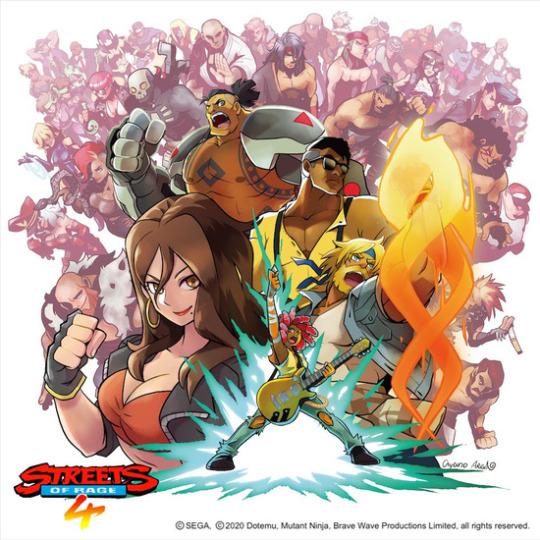
Genres: Electro House, Nu Jazz, Synth Funk, Acid House
Composer Olivier Deriviere is a living definition of a video game soundtrack journeyman. He has a career stretching back to the early 2000s working on notable big budget titles like the divisive 2008 Atari fifth Alone in the Dark installment and Remember Me, an unsung buried gem from the PS3/360 era Capcom title. Remember Me is where Deriviere’s electronic leanings started becoming especially prominent in his sound. On the Streets of Rage 4 soundtrack Deriviere has completely come into his own element, developing a whole new sense of campy playfulness.
Electronic French House music can be a divisive genre. For every Daft Punk commercial success there is a band that ruffles feathers like Justice. I sense a strong presence of late departed French House titan Philippe Zdar of Cassius as well. If you’d played this soundtrack for me out of context, I would have guessed an obscure voguing tape from the 80s or a really talented mysterious DJ set. Instead, this is a sequel to a classic beat em up franchise that left a portion of players disappointed by the game’s four hour playtime. The soundtrack is over an hour and fifty minutes long of high octane House music bliss. Much like the Tetris Effect soundtrack, it is truly impressive how much depth these tracks have when they could have easily been nostalgic recycled beats. Sometimes a game’s soundtrack can offer more post game enjoyment than an actual game.
Notable Track: Chill Or Don’t
---------
Hylics 2 by Chuck Salamone & Mason Lindroth

Genres: Experimental Rock, Neo-Psychedelia, Hypagogic Pop, Stoner Rock, Jazz-Rock
A soundtrack that comes closest to capturing the experience of hearing the Earthbound or Katamari Damacy soundtracks for the first time. The Hylic indie RPG series is a wonderful and strange beast that is ready to frolic and show its playful side. Hylics is a part of a recent uprising of indie games being developed on the RPG Maker software. 2020 year has left us all with variations of the same stressed out adjectives: Weird. Messed Up. Surreal.
Why not listen to an album from a game that is the perfect embodiment of that surreal mantra? Step away from your computer, draw a bath, and put this album on. Thank me later!
Notable track: Xeno Arcadia
---------
Ultrakill: Infinite Hyperdeath (Act I Soundtrack) by Heaven Pierce Her aka game developer Arsi “Hakita” Patala

Genres: Drum and Bass, Industrial Metal, Ambient, Progressive Metal, Acidcore
Nothing says “modern indie game development” more than a game built completely from the ground up by one person. Ultrakill’s developer “Hakita” is one of those kindly folkloric DIY figures that make video games such an extensive art form. The game is a painstaking gloriously bloody ode to Dooms of yesteryear but with plenty of its own fine tuned style. The perfect soundtrack for when you’re painting your personal Hell a darker shade of gore, but also would really like to kick your ass into shape if you need an adrenaline boost to your Quarantine blues.
Notable Track: Panic Betrayer
---------
Risk of Rain 2 by Chris Christodoulou

Genres: Progressive Rock, Space Rock, Space Ambient, Post-Rock
Something about the country of Greece brings the best kind of futurism out of the country’s composers. Christodoulou’s Risk of Rain 2 soundtrack is no Bladerunner knock off. This soundtrack for the colorful sci-fi indie rougelike is punchier and less nocturnal than your typical synth-heavy sci-fi soundtrack. Risk of Rain is one of the more successful Kickstarter series around and has the best quality an indie game can have: it feels like a labor of love on all fronts. There’s no reason a rougelike like Rain of Ruin or Hades needs a soundtrack this good, but Christodoulou casts a spell with his electronic-driven prog rock that makes you want to keep respawning. A huge missed opportunity if Christodoulou does not get to soundtrack an earnest sci-fi action-adventure for even big screens. Oh! This soundtrack also features some spoken word segments from Werner Herzog; what more do you need to know?
Notable Track: The Rain Formerly Known As Purple
---------
Warhammer 40,000: Mechanicus by Guillaume David
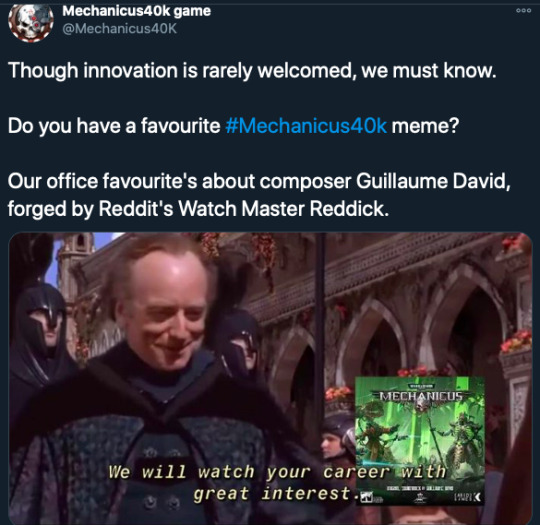
A big debut project from an up-and-coming composer Guillaume David. Prior to the making of this soundtrack, David was a video game voice actor who worked on a Resident Evil Devil May Cry crossover voicing the character of “Hunk.” Warhammer 40K might become a franchise that more people will care about solely based on the quality of this installment’s soundtrack. When you see the title Warhammer 40,000, what sort of sounds come to mind? If you guessed “Neo gothic cyber Gregorian chants that seamlessly melds the ancient and futuristic”, you would be correct. A turn-based action game could possibly fall into dull territory, but with a visual identity as strong as Warhammer 40K melded with a suitable musical atmosphere, the action and world becomes irresistible. This soundtrack is a brisk 56 minutes and the other soundtrack on this list with a more conventional runtime. Not a second is wasted on this dynamic and fantastical soundtrack. Prior to hearing this soundtrack I had no intention of ever looking into playing a game based off of something as convoluted as Warhammer 40K, but now I very much want to know what these robot priests are about. That’s the magic of a quality soundtrack.
Notable track: Millenial Rage
/////
Honorable Mentions:
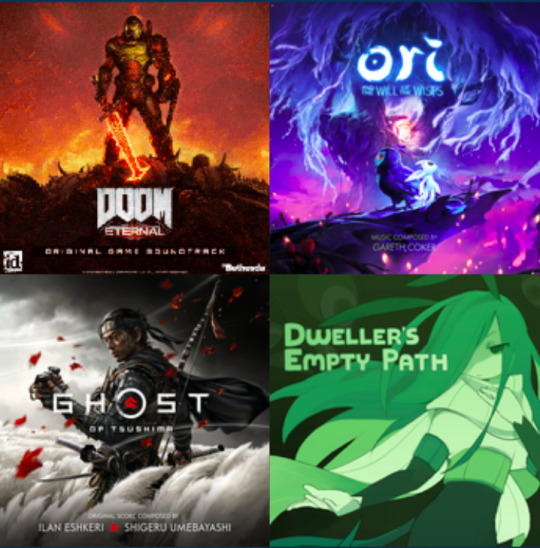
Happy Listening!
#Video Games#Video Game Music#Soundtracks#Top 10#Video Games 2020#Final Fantasy 7#Persona 5#Streets of Rage#Hylic#Utrakill#Risk of Rain#indie games#Square Enix#Warhammer 40k#last of us#Last of us 2
132 notes
·
View notes
Text
The Best Japanese Fantasy Action Game from 24 Years Ago – Onimusha Review
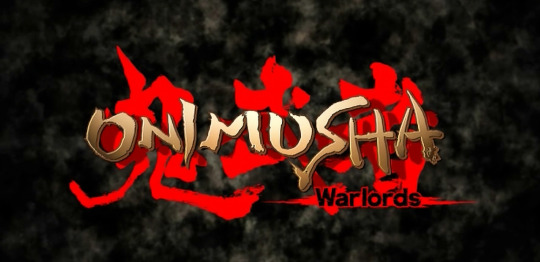
1.Introduction
Game Title: Onimusha: Warlords Release Date: January 16, 2019 (PC Remastered Version) Genre: Third-Person Action Hack-and-Slash Playtime: 3-5 Hours Overview: Onimusha: Warlords is a remastered take on the 2001 classic, set in Japan’s Sengoku period with a fantasy twist. You play as Samanosuke Akechi, a samurai battling demonic Genma in a sprawling Japanese castle. Heavily inspired by Resident Evil 1, it blends pre-rendered backgrounds with 3D characters, offering a mix of exploration and puzzles in a box-like world—a Japanese fantasy spin on Resident Evil.
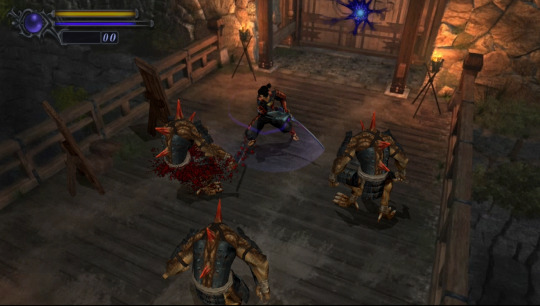
2.Gameplay Mechanics
Three Elemental Weapons
As you progress, you’ll wield three elemental weapons, each with unique strengths and magic attacks fueled by blue souls:
Raizan: A lightning katana with balanced speed, great for chaining hits on single foes. Its magic unleashes a flurry of electric slashes, capped with a massive thunderbolt—perfect for tough enemies.
Enryuu: A fire broadsword that’s slow but hits hard, staggering foes with ease. Its magic sprays a line of flames, piercing shields and shredding bosses or elites.
Shippuu: A wind-based double naginata, fast and wide-ranging but lighter on damage. Its 360-degree whirlwind magic clears out mobs in a flash.
Issen (Critical Strike)
The “Issen” mechanic is the series’ standout feature. Time your attack just as an enemy swings, and you’ll land a one-hit kill, dropping a pile of souls—especially the rare yellow ones that heal. It’s tricky to nail the timing, a hurdle for newbies, but for veterans, it’s a clutch move when health’s low and supplies are gone.
Box-World Exploration & Puzzles
Like Resident Evil 1’s mansion, Onimusha unfolds in a Japanese castle. You’ll roam compact rooms, rummaging through books and chests while fighting off enemies. Some doors require puzzle items, earned via mini-games, to unlock new areas. Others are sealed by magic, needing a specific weapon leveled up—like a purple seal tied to a Lv2 Raizan.
Soul Absorption & Survival Pressure
Killing enemies drops red, yellow, and blue souls. You absorb them by holding a button, leaving yourself open to attack, and they vanish if you’re too slow:
Red Souls: Upgrade weapons (Lv1 to Lv3) or enhance items—like turning herbs into medicine or arrows into fire arrows.
Yellow Souls: Rare and vital, they restore health. With scarce medicine and no auto-healing, they’re a lifeline.
Blue Souls: Also rare, they refill magic, key for taking down elites since magic doesn’t regen otherwise. No auto-recovery, limited ammo, and finite medicine mean every hit counts. Run out of healing at low HP, and you’re stuck reloading an old save.
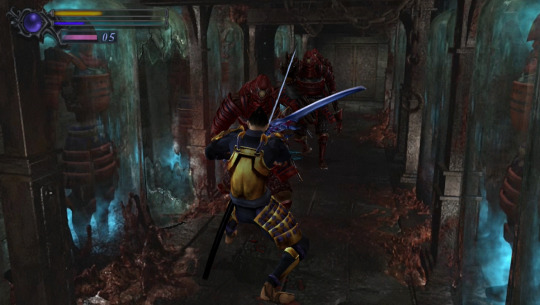
3.Progression & Collectibles
Exploration yields goodies to boost your stats:
Fluorite: 20 hidden pieces, invisible without a special item. Collect all for “Oni Mode.”
Magic Jewels: 5 total, boosting max magic.
Power Jewels: 5 total, raising max health.
Files: 32 bits of lore, like letters and maps. Four books (16 files) unlock treasure chests with Jewels inside.
Bishamon Sword: The ultimate weapon, trivializing the final boss. Earn it by clearing 20 waves in the Dark Realm and using a puzzle item before the end.

4.Unique Flavor
I first played Onimusha 20 years ago, and it blew me away—a 3D action game pitting a samurai against fantasy beasts in feudal Japan. The detailed castles and stylish monsters stuck with me. Revisiting it now, it still holds up as one of the best in its niche, outdone only by the Nioh series. The Issen mechanic adds a thrilling edge that’s hard to beat.
5.Story & Worldbuilding
Plot Summary
Set in the Sengoku era, Samanosuke returns to a castle after a plea from Princess Yuki, only to find it overrun by Genma. Nearly killed, he’s saved by the Oni, who grant him a magic gauntlet. Teaming up with ninja Kaede, he fights to stop the Genma from sacrificing Yuki.
Characters & Depth
Historical figures like Samanosuke, Hideyoshi, and Nobunaga pop up, but they’re far from their real selves—more like cardboard cutouts. Kaede and Yuki fare no better, leaving the story shallow and forgettable.
Worldbuilding
Files paint a mythic clash between Genma and Oni, but with limited levels, it barely comes to life. Most of the game sticks to realistic castles, with scant fantasy flair to flesh out the lore.
6.Visual Experience
Art Style
Pre-rendered realism meets Japanese flair. Characters and settings feel authentic, while monsters and weapons carry the fantasy vibe. Samanosuke, modeled after actor Takeshi Kaneshiro, was a bold choice for 2001, letting you soak in feudal Japan’s aesthetic.
Design Consistency
Early enemies—think ashigaru, samurai, ninja—fit the historical vibe perfectly. But later tentacle monsters and the final boss feel out of place, clashing with the Japanese tone.
Detail & Impact
For 2001, the visuals were jaw-dropping—cinematic scenes and detailed armor. In 2025, they’re dated next to Nioh or Ghost of Tsushima, though the pre-rendered backgrounds still hold charm.
7.Controls & UI
Control Feel
The original tank controls and fixed camera carry over, though the remaster adds stick movement. Enemies can hide off-screen, and no lock-on makes aiming clunky for modern players.
UI Design
The combat UI is clean but barebones—no weapon wheel or hotbar. Healing means pausing and digging through menus, a relic the remaster didn’t fix.
8.Difficulty & Challenge
Difficulty Curve
Normal mode is forgiving—enemies aren’t too aggressive—but no auto-healing and scarce supplies demand caution. Grab the Bishamon Sword, and it’s a cakewalk.
Challenge Factor
Issen steals the show. Its tight timing window, with no cues, tests your reflexes. Nailing it feels amazing, especially when it saves you from death.
Learning Curve
Controls click fast, but Issen’s a trial-and-error beast with no hand-holding.
9.Conclusion & Rating
Overall Take
Onimusha: Warlords is a stellar Japanese fantasy action game that still shines 24 years later. Its short 3-hour runtime and simple mechanics make it a “dessert” title—best for fans of historical fantasy or retro vibes.
Strengths
Punchy combat and thrilling Issen mechanics
Nostalgic pre-rendered beauty
Weaknesses
Thin content and low forgiveness
Dated visuals by today’s standards
Who’s It For?
Fans of Japanese historical fantasy or vintage games.
Scores
Gameplay: 7/10
Story: 6/10
Visuals: 7/10
Controls: 7/10
Overall: 7/10
1 note
·
View note
Note
um... you play instruments right? i'm trying to write characters that are going to put on a show together but i have absolutely no idea about music. i just wanted to ask, how long would it take/you give yourself to practice a piece that is like 5 minutes long? 15 minutes? 30 minutes? like... if you know how to play the instrument, how many days would you need to practice the music?? idk terms either oops... if not, just disregard this ask lol
Hey, Anon! You’re right; I do play instruments–a bit of piano/organ but mainly alto sax. (Also voice and handbells, as part of choirs.) That’s a more complicated question than you realize, though. It depends a lot on the person and the type of music/difficulty of the song as opposed to the length of the song.
The longer someone has been playing a particular instrument, the better they are at it. In a relatively simple piece of music–not too fast, not too many black notes (faster sections, since the white notes are held for a longer period of time), easy key signature and time signature that don’t change every few bars (not a lot of sharps/flats/accidentals which are sharps or flats not in the key signature and the counting isn’t )–some experienced people could sight read it without much trouble. That is, see it for the first time and play it through very well. Less experienced people would take longer, and how much longer would depend on how long they’ve been playing that instrument, how long they’ve been reading music (if it’s not the only instrument they know how to play, they might have been reading music for longer), and how complicated a particular piece of music is.
When most people practice, they don’t play the entire song over and over. They’ll work on the sections that give them the most trouble. They’ll play it slower, trying to get the timing right and then the notes right, and then they’ll work on playing it up to speed. (You can use a metronome to help you with this, to tick every beat.) The more difficult sections there are, the longer it will take. I’ve practiced two different sections in the same song (read: multiple bars of running sixteenth notes (which are quick), trying to get the right metering (the beat in the right spot) and the right emphasis and the right notes at the fast tempo we’re supposed to be playing it at) for two hours straight and felt like I’ve made no progress. With a different song, a much easier song, I’ve played through it three times with someone (my accompanist) and then played it for a concert.
There are also people who can hear a song and then sit down and play a close approximation of it–good enough that you as a listener might not be able to hear much of a difference from what you were expecting. This is called having a good ear. Some of these people have what’s called perfect pitch–hearing a note and being able to name it and mimic it exactly (with voice, or hit the right note on the instrument if it’s an instrument); a lot of them have what’s called relative pitch, where they’re still very good at knowing their intervals and getting stuff right or faking it if they get it wrong. The rest of us have to practice more to get to their base level. Even people who can’t play a song (even a simple one, like happy birthday or the national anthem) without music learn a lot by ear, though, especially if it’s something like jazz. Sometimes, what’s written on the page is not what’s actually played, depending on the style of music. (It’s the equivalent of reading between the lines.)
That being said, I know multiple musicians who cannot read music. It means nothing to them. They learn entirely by ear–listening to a song over and over and working it out. Most of these people sing, play guitar, or play the piano, but for those who play instruments like the trumpet, they’ve learned how to make a certain note on their instrument but have no concept of what that note would be on a different instrument, and they could not tell you that it’s an A or a G or a B flat or a C sharp, just that that’s how they play it.
Five minutes is longer than you think it is in music. Most of the songs I play run about 2-4 minutes, and in the longer ones–7 minutes? 11-15 for ones with multiple movements or featuring quartets/quintets with a band backup, but those are outliers for my norm–I have a lot of bars of rest where I don’t play at all. Some songs are slower and take longer; a one page song with multiple repeats and a slow tempo (say, quarter note = 70) could be the same playtime length as a more complicated song with three or four pages at a faster tempo (say, quarter note = 160) or which starts slower and then switches to a faster tempo. Some songs have a lot of repeated sections. Some of them feature solos. If you’re playing an instrument that requires you to blow air to sound it–woodwind, brass–then the more you play without getting a rest in the music, the more tired you get, and the harder it is (with brass instruments especially) to hit notes in tune. In longer songs that feature vocals, there are often instrumental breaks where the band plays and the singer gets a chance to rest, or different solos where a particular instrument is featured (piano, bass, guitar, sax, trumpet, depends on what kind of music you’re playing) as much to highlight the skill of that player as to give other people a chance to rest. With jazz music, a lot of solos are improvised. Some people are very, very good at making up a solo on the spot. They are at a skill level where they don’t need to practice to do this. Others (like me) cannot do that at all and need to write something out and try to follow that.
I know people who practice diligently for at least an hour every day, and then a three hour weekly practice with their band, to prepare for a concert in two-three months (somewhere between 15 and 45 minutes of music). I myself tend not to practice as much as I should on my own for the first month and then try to put in an additional 1-4 h/week on top of the 3 h group practice in preparation for a concert, usually practicing 1-3 times a week, depending on how much time I have and how prepared (or rather, unprepared) I feel. Most music groups will meet one night a week and expect their members to practice on their own time; depending on how busy people are and how prepared they are for something, there might be additional practices, but it can be difficult to free up more than one night a week for multiple people.
For one-off concerts that aren’t a regular thing with a regular group, I don’t tend to practice as much because that tends to be easier music. Maybe five times before the concert itself, for a single song, sometimes just playing that song once or twice with whoever I’m playing it with, sometimes working on it a little longer by myself if there’s a tricky timing/more difficult part I need to work out, but I wouldn’t spend more than half an hour on it at once. (So, with a song with a tricky part, maybe 1 h total by myself and 15 minutes total with someone else. If not a tricky part, well, maybe half an hour total. I dunno. I did a two minute song for a concert earlier this month and practiced it three times; it was a very straightforward song, and I had the melody, and I knew the melody.) That being said, I am related to people who practice once before the concert and call it good (for a song or two), 2-5 minutes, and who probably wouldn’t practice at all except they all collectively go, “I guess we should practice this once.”
tldr; different people will practice the same song for different periods of time. Some people might not practice at all on their own and just practice when they show up to the group practice, and if they’re skilled, this might not matter. If they’re less skilled, and the others practice, their lack of practice will be more evident. People can work on a song for months or for a week, depending on how easy it is and how good they are at music. Unless your characters are getting a specific song ready for a specific concert/show, they will be learning to play more than one song at once. Listening to a song they’re trying to learn will help them learn it faster, and they’ll hash out the more difficult parts in practice rather than play through the entire song with all the easy parts that they don’t need to really practice because they can already play it well. (Also, didn’t say this before, but learning the timing and rhythm is often more important than learning the notes; the notes come after.)
(tiny addition)
#ladylynse#music#asks#tbh my experience is mostly jazz concert band music and church music#with some folk and disney and pop and rock thrown in#so I dunno how much this helps#feel free to ask me to clarify#or to expand upon something#or to give you a quick run down on reading music if you think that'll be important#Anonymous
11 notes
·
View notes
Text
Castlevania: Curse of Darkness ~ It’s Just Like Symphony of the Night, Except Not At All! [Part IV]
When asked recently if Curse of Darkness is good, I answered: no; but, I’ve played through it about ten times. So, on a subjective level that can’t really be transmitted to other people by telling them what to focus on (although I’ll try to enumerate what I focus on), there is something here that, well, I just like. I’m not the sort of person to make the claim that, “[X] is a fine videogame, but a bad [series-name] videogame.” That’s not my conclusion -- to suggest that there is an inherent goodness to the series I like just because it generally excites my palate, and that anything below one’s standard is a “betrayal” of that inherence.

Even though difficulty isn’t what I go to videogames looking for, I think what makes Curse of Darkness work best for me is its hard mode, accessed by finishing the game once and then inputting “@CRAZY” for your file name on a new file (the same goes for Lament of Innocence). The norm for the Castlevania series and iterative challenge has been “loops” -- clearing the game once and then having it roll over automatically to a new game, whereupon enemies deal more damage and are perhaps more numerous and/or newly appearing. Although these adjustments have provided an extra challenge, the presence of new material, of differing enemies or enemy placements, has tended to be relatively minimal. The first Castlevania, for example, halts its modifications on stage four on subsequent loops. CoD’s hard mode is remarkable in that pretty much every area has been edited for enemy type and occurrence. It is also, at least on some hypothetical level, the toughest of any Castlevania hard mode. Hours in, you will still be easily slain in just a few hits, your curative capacity is strict, and money is tight. What all of this means, for me, anyway, is that Curse of Darkness becomes a sort of brutal dungeon crawler: the endurance which the level design, by default, asks of the player better matches what you need to do in order to survive until the next save point.
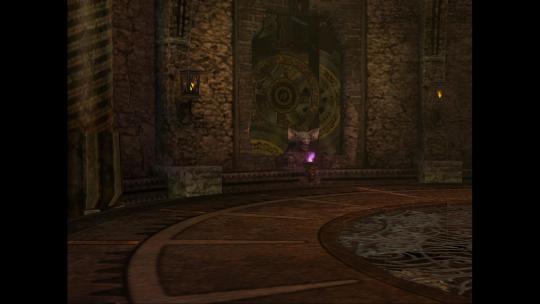
What it also means is that you might be compelled to more intentionally curate your familiars, here called Innocent Devils. Normally, these critters are absolutely peripheral, excepting a handful of spots where one’s ability is required for progress. On hard mode, having the right familiar in the right situation, using the right abilities, is an enormous help -- sometimes, the difference between your life and death. If I could retroactively magically redirect all of the labor poured into the Innocent Devils to the level design, of course I’d do it in a heartbeat; but the variety that effort produced -- the physical differences between a Devil’s evolutionary forms, their skills, and the descriptions for each (two of my favorites: “A star motif graces the rod of this mage. Its owner dreams of one day becoming one with the stars”, and “Pure rage in corporal form, it is chaos with wings. Many find its anguished form hard to look at”) -- has its place among the rest of the game’s marginalia. Without them, too, Curse of Darkness would perhaps be an overly lonely experience.

Curse of Darkness has something in common with KCET’s post-Game Boy Advance Castlevanias (most of all Order of Ecclesia), which is that its bosses are excellent -- fun to look at and fun to fight, especially on hard mode, where precise mechanical execution is mandatory. The downside is that they are, in fact, so good that returning to the game as usual after each can be especially deflating. Just as fun are the narrative interludes featuring some wonderfully on-point voice acting by, best of all, Liam O’Brien (as Isaac) and Adam D. Clark (as St. Germain), and, somehow, some of the subtlest facial expressions found on the console. To be sure, the characterizations are limited -- caricatures more than characters -- but what they lack in humanistic texture (something perhaps not to be sought in this series) they make up for in flair. People might pick on the Lords of Shadow titles for resembling “high fantasy” ersatz with doses of Castlevania jabbed in wherever, and while that is a fair criticism, just as awful was the games’ relentlessly grieving tone, as if a suffocating sense of self-seriousness were what the material needed for effect. Curse of Darkness’ tonal strain -- reverential, obscurantist, and funny -- could not be unlikelier. There is the rendering of Trevor Belmont, after we first fight him to no avail, as a near-saintly figure; the inscrutable, fanfiction-like logic guiding the major plot beats; the way Hector, as protagonist, slams between ridiculous shrieks of vengeance and introspective “Indeed”s. It is, all in all, maybe the best-relayed storyline Castlevania has ever gotten, and maybe will ever get.
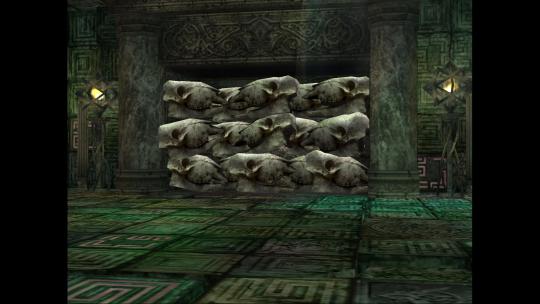
If there’s one mechanical idea, separate from the Innocent Devils, to applaud, it’s the stealing mechanic, whereby Hector can snag various items from ghouls and ghosts if done at the proper time. This is indicated by the lock-on reticule momentarily switching from orange to purple, and often requires waiting for certain animations to begin or finish. It’s a neat micro-challenge to engage if you’re so inclined (bosses are where it shines; the Wyvern, for example, has an optional aerial sequence that’s tied to the steal-window), and a nice alternative to item drops being determined by randomized success/failure rates. To be clear, randomized drops do still exist -- they’re there in the bestiary as a delineated datum -- but they’re no longer the sole possibility. For some, this mechanic might also serve as an invitation to observe Dracula’s army with a heightened degree of purposefulness, to better appreciate the effort that went into giving its members life. However viewed, it’s kind of a shame that the idea remains unique to Curse of Darkness. I suppose pure statistical randomness pumps up the playtime for anyone who enjoys grinding; but the intentionality underpinning the stealing mechanic, the terms of its execution and our means of utilizing it, is a tantalizing window into an alternative, less number-crunchy shape for the action-RPG mold of Castlevania.
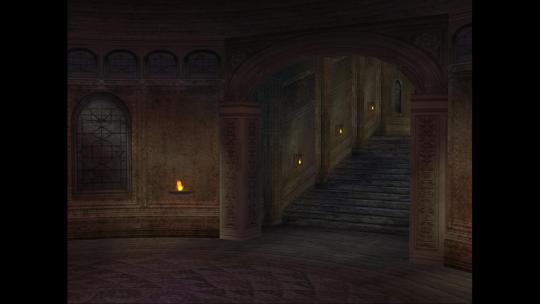
And, really, for as often as Curse of Darkness’ visuals compare unfavorably to Lament of Innocence’s, I couldn’t’ve taken as many photos of it as I did for another lo-fi-/CRT-dedicated project last year (a fraction of the results can be seen here and here) if the game’s world didn’t have an ambient luminescence of its own, albeit one thinned out by the aforementioned issues with the scope and camera, and several stale settings. In a fashion seemingly particular to PlayStation 2 releases, scores of exterior and interior spots are clothed with polychromatic, sourceless “lighting”, such that a wall’s surface might go from a deep blue to a brown-green to a purplish red. Taken as a sum, Curse of Darkness’ Wallachia is dim and gray-faced; taken constitutionally, it’s in fact abounding with colorful dispersions. Especially delightful for its brazenness is the pause menu/status screen, centralized by a pillar of neon-green stamps, headlined by a teal and an orange ochre banner, and itemized on the right by a stack of iconographic boxes. As coloration and organization go, compared to Lament of Innocence’s screen, it’s sloppy. But as a chunk of graphic design to linger in, it’s delicious, and happily recalls Harmony of Dissonance’s palettes (also directed by Takashi Takeda).
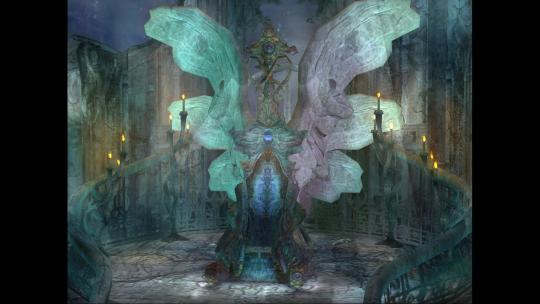
Well! That’s nearly all I have to say about Curse of Darkness right now. I’m curious if the animated Castlevania series’ second season, featuring Hector and Isaac (Isaac is physically recast and no longer queer-coded in the way media tends to do that coding; a gain and a loss, in my opinion), got some people to try this game out for the first time. If it did, I’m also curious if the show’s characterizations transferred over, maybe allowing those people to enjoy Curse of Darkness in a way foreign to myself (no, I still haven’t watched the show) and others. Could the imaginatively supplementary reach of fanfiction sustain such a playthrough? Surely it’s possible.
You can read the prior three essays on CoD here, here, and here.
24 notes
·
View notes
Text
GIGABUSTER Level Design
In preparing for GIGABUSTER's level designs, I spent a good amount of time dissecting the structure and pacing of older Megaman and Megaman X titles, going so far as to measure the amount of time between enemy encounters, the distance traveled, the amount of space given for movement, etc.
I combined all of these observations with nuggets from old interviews with Megaman developers, and came up with a "formula" of sorts for building out levels. This formula involves a few rules that I wanted to write about.
1: No more than 3 elements on screen at once
This was something from a Megaman 1 interview you can find [here]. Not only would more than 3 interactive elements on screen be taxing on NES hardware, but it was also difficult to parse a scene quickly for the average player. You could also build from this with the idea of "focus," having the elements you'll need to pay attention to grab the player's eye in a specific order (similar to focal points, where your eye will immediately center on a specific point before wandering elsewhere).
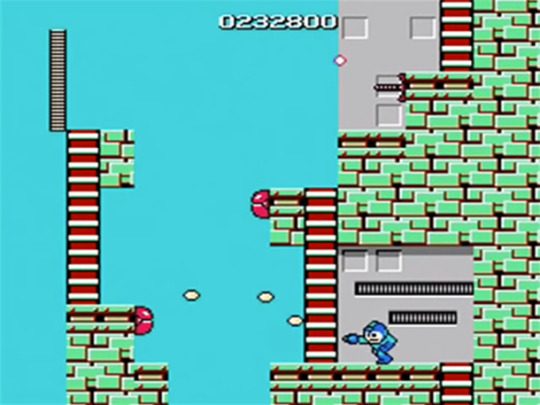
(An example of 3 enemies at once from Cut Man’s stage. In early Megaman it was also rare to have more than 1 enemy type mixed in.)
To make sure I wasn't putting more than 3 elements on screen at once, I tile a 1920x1080 square in the background of every level in GIGABUSTER. That way, I can measure the distance between elements and the amount of them within the game's screen size.
On top of this, GIGABUSTER uses a ton of custom camera regions, which will hover the camera to certain points when walked into. Enemies will only activate when they're on screen, so this not only helps to keep elements in focus, but also makes sure enemies will activate predictably.
2: Four-step design
This is something you can learn more about [here].
Four-step is also something written about by early Megaman developers, though their versions of it differed slightly. Early Megaman games only introduced mechanics in "sets." For example, a screen that introduces a Met would be followed by two to three more Met screens. This is really prominent in almost all old Megaman stages; you can almost take your pick of any of them and see this in action. Here's [Wood Man] for example. The entire stage is is 4 sets of 3-step enemy introductions, with very little crossover between the enemies being introduced.
Typically each set would focus on only one enemy type, with others only introduced to "mix up" the 3rd encounter.
Simply put, Four-step pacing usually goes like this: First encounter: An easy introduction/tutorial to an enemy type. Low risk. Second encounter: A slightly harder encounter with the enemy, either by putting it in a less convenient position or situation. Third encounter: The hardest one. Ideally, this one should build on the enemy in an interesting way. Typically by combining it with other enemies or mechanics. Fourth encounter: The wind-down, mop-up or finale. This one should be easier, usually mirroring the second encounter in a way that leaves the player feeling rewarded for overcoming the climb to the third encounter.
For an example of this in GIGABUSTER, take the Grenadier section of the Oil Rig.

In this set, you can safely drop into the first encounter whenever you like. You also get to see the enemy's attack pattern before dropping down. The drop is positioned so that you'll be standing underneath the grenade's arc, so even after dropping you're mostly safe from damage. In the second, you no longer have the height advantage. You have to approach the Grenadier head-on, meaning you'll have to avoid his attacks normally. It's a less ideal positioning. The third combines the second with a new enemy type. The Driller makes it difficult to sit in one spot, meaning you can't stand under the grenade's arc for too long. This one is the hardest encounter. (However, as a bonus self-imposed challenge, leaving the Driller alive lets you jump on its head to grab an HP UP.) The fourth mixes in torches, but they're static and don't prevent you from hiding under the grenade's arc. They may make the section look difficult, but it's closer to the 2nd in challenge.
Even if these encounters are very difficult, the bookending of the first and fourth will leave the player feeling better about the situation than they otherwise would've, perhaps making them feel more likely to give the set another go if they lose.
Another great example of this bookending is in Super Meat Boy. Usually (but not always), the end of a level in Meat Boy will have a slightly easier stretch, making you feel better about the level even if the majority of it was extremely tough.
Finally, I'll add that while four-step design is a good way to lay out encounters, GIGABUSTER doesn't adhere to it 100%. There are occasional mix-ups of other encounters along the way, hopefully making the stage not feel quite as formulaic as it otherwise would've while still keeping the satisfying pacing of four-step for most encounters.
3: Speed
Finally, something I can't cite by any interviews or videos. Speed is very subjective from game to game (even within the Megaman series). This rule simply measures the amount of time the player spends on encounters and levels. Megaman developers have been open about how they intentionally design their games to be finishable in about an hour, so I tried to translate this into encounter length as well. Movement speed also plays into this, as games with slower-moving characters often slow down even more when played at HD/Widescreen resolutions, as the levels themselves become wider. I wanted to keep the speed and pacing of Megaman Zero games inparticular consistent, even when translated to an HD Widscreen format, which also meant speeding up the characters beyond their original inspirations.
While I don't have any direct links, I remember reading about how play sessions are best divided into time segments. In JRPG's, for example, the sweet spot for a normal encounter's length is about 3 minutes maximum, ideally ending in around 3 turns.
For GIGABUSTER, I wanted stages to be complete after roughly 10 minutes of gameplay. But for games that push longer playtimes, you may notice that these times often work in multiples of 5-10. For example, I often found that Shovel Knight stages would last between 15-30 minutes on a first playthrough, from both personal experience and from watching others.
Also noteworthy, some games are much slower paced, whether because they like a run or dash button, or because they're very puzzle and platform heavy. An important thing with a game like GIGABUSTER is making sure the momentum doesn't dip too much. There are certainly sections (like the elevator in the Oil Rig) where progress slows down, but in general I like to think most sets of encounters has a similar range of length to completion.
There are certainly other rules I haven’t mentioned here (integrating optional challenges is another big one), but these are the three that come to mind the most when designing GIGABUSTER. Thanks for reading!
16 notes
·
View notes
Link
A Boxerdoodle dog is the result of breeding a Boxer breed and a Standard Poodle breed. Many people like the canine due to its adorable physical traits and personality. If you want to know more, then read the topics below:
What is a Boxerdoodle?
source: nicolebarrebreaux
A Boxerdoodle is not a purebred canine but a hybrid type that is a mixed breed. The breed is roughly a decade or two old and was created in the U.S. which is the reason why this breed hasn’t had a long history yet. However, the canine’s antecedents which are the Boxer and the Poodle the does have a long history.
The Boxer is from Germany and was bred during the 19th century from hunting dogs. The canine arrived in the United States in 1903, and during World War 1, the United States Army used the animal as an attack dog, guard dog, pack carriers, and messengers. Today the Boxer is pet companion, but it still can be an excellent watchdog that is alert and watchful.
Like the Boxer, the Poodle’s origin is also from Germany, though the current Poodle that we are familiar with was bred and developed in France. The dog’s original purpose is to be a hunting dog and a retriever of waterfowl. This canine is one brightest dog breeds and is a good family pet and gets along with children.
Being a Boxer and Poodle mix, the Boxer takes some traits in looks and personality from both of its antecedents.
The Personality of Boxer Poodle Mix
One trait that dog lovers like about this Boxer Poodle mix breed is its personality which combines playfulness with seriousness. During work times, the canine takes it to work seriously and is calm as well as the patient. But when it comes to playing with you and your family, the family dog traits like being affectionate and friendliness will show up. Boxerdoodles also have a protective personality. The dog is not aggressive like other canine breeds, but if it senses potential danger to you, your family and home, it will be a steadfast guard.
Due to the dog’s friendly nature (along with proper training and socialization) it works well as therapy dog making it a boon for the elderly and sick.
Poodle Boxer Mix Appearance
A Boxerdoodle dog’s nature is not the only thing that people like about the canine; its appearance is part of it. Boxerdoodles’ appearances tend to differ from dog to dog since it is possible that the breed may favor one side of parents or have both traits. So a Poodle Boxer mix canine may have the Poodle’s wavy, curly coat, the Boxer’s smooth short coat or both. The dog’s coat has a variety of colors that you would love:
Fawn
Brown
White
Black
Red
The coat’s color is either single colored, brindled or parti-colored.
The dog breed‘s size ranges from medium to small. Individually the canine may reach the height of 10 to 12 inches, and the weight of the breed is 12 to 70 lbs (5.55 to 31.75 kg).
Boxerdoodle Pictures
Lots of side eye action going on here. Swipe and watch Charlie’s eyes 👀 #nationaldogday
A post shared by Cassie (@lovecassiexo) on Aug 26, 2018 at 2:07pm PDT
Here’s a few photos of Charlie when my humans first adopted him almost 10 years ago. He was sent home with a giant flea collar that Mum wanted to trim but he wouldn’t let her. He hid behind the vine of a big tree in the yard for a while, till he realized nobody was going to hurt him.
A post shared by Cassie (@lovecassiexo) on Jul 26, 2018 at 6:24am PDT
"Dogs’ lives are too short. Their only fault, really.” – Agnes Turnbull. My sweet little and gentle old Zoe. I love her so much. 11 years of pure love. #dogs #love #dontshopadopt #boxerdoodle
A post shared by Patty Fountain – Redman (@patty_fountain) on Aug 8, 2018 at 6:51pm PDT
#boxerdoodle #boxer #poodle Love it 😂
A post shared by @ kickthebaby666 on May 31, 2018 at 1:05am PDT
The Boxerdoodle’s Temperament
Despite being bred as a working dog, the Boxerdoodle has the traits that will endear you to it. Regardless of its nature as a working dog, the animal is friendly, devoted and possess a loving character to you and your family. If you have any kids, the canine will love to play and socialize with them.
Loyalty and protectiveness are also traits possessed by this Boxer Poodle mix. The dog shows little or no aggression if a situation is normal, but if it senses a possible danger or threat, it will defend its home. When it comes to strangers, the animal has more reserved demeanor but will open up to them once familiarity sets in.
Health Issues of a Poodle Boxer
It’s a fact of life that dog breeds like the Poodle Boxer mix suffer from several health problems. Being a Boxer and Poodle mix breed, Boxerdoodles tend to have some if not all of the issues that their bloodline parents. Here at least four examples of health issues affecting this canine:
Von Willebrand’s Disease – To put it simply, this disease cause Boxerdoodles to bleed out or hemorrhage. Von Willebrand Factor or VWF is an adhesive glycoprotein that is responsible for clotting the dog’s small blood vessels that have injuries. Without the VWF, coagulation does not happen, and the injured small blood vessels will continue to bleed. Symptoms are nose-bleeds, blood in urine as well as feces, bleeding gums and bleeding vagina if the canine is female.
Hip Dysplasia – One of the most common physical problems that plague dogs regardless of their breed type. A canine’s hip joint is composed of a ball that fits snugly in the hip joint’s socket. Should deformation occur due to failure to develop normally (malformation) in the hip joint, the ball will not fit in the cavity, and it can lead to the loss of the hip joint’s function. Hip dysplasia onsets earlier on dogs that are four months old, but sometimes the condition occurs later in the canine’s life.
Degenerative Myelopathy – This problem causes a slow, but progressive, non-inflammatory degeneration of the spinal cord’s white matter. Without a veterinarian checking the problem, you can confuse degenerative myelopathy for unrelated orthopedic injuries.
Bloat – When gas fills up a canine’s stomach, bloat happens, and the unnatural expansion of the stomach put pressure on the diaphragm. This situation causes the stomach to twist and make breathing hard. Large dog breeds with deep chests are commonly affected by bloat. Most of the time, vigorous exercise or activity after meals causes bloats. The animal has an enlarged abdomen one sign of bloat.
Some health problems are hereditary while others are caused by outside factors like the environment, food, and injuries. Other health problems are allergies and heart conditions. Some of these problems are preventable, while can be mitigated if dealt with quickly. Do not let illness get severe or escalate since it can prove lethal to your pet. A regular check-up by a vet should give you enough warning of your pet’s physical condition.
Is the Boxerdoodle Good as a Guard Dog?
Due to the origins of the Boxerdoodle, it is suitable to be a guard dog. The canine is naturally inclined to protect its family and will bark if something is not or senses a threat to your, its family as well as home. The breed gets it protective guard dog trait from it Boxer ancestry.
Training and Exercise for Boxerdoodles
The Boxerdoodle breed has intelligence and can be quite an active animal. Giving your dog training and exercise shouldn’t be too hard.
You can quickly train and manage a Boxer Poodle mix breed since the canine is by nature bright, sensitive and smart. Along with some treats and rewards for the canine’s training success, it will respond well to your training. Avoid at all cost rough, oppressive methods as well as harsh treatments since these are detrimental to the animal’s training. At worse these methods will backfire and make the canine more stubborn. Boxer Poodle puppies and adults can equally have training, but training the former is more comfortable than the latter. You can instill obedience in a puppy via training and socialize them by introducing them to other dogs. Do not forget to be fair, firm and consistent during practice.
Exercises are an excellent way to keep your pet physically healthy and fit. Since Boxerdoodles are medium or large-sized dogs, they need of space to move around. If your home has a backyard with more than enough space as well as fence, let your pet frolic within it. On a daily basis, the dog needs at least one hour of exercise outdoors. Walks, jogs, runs and playing is adequate exercises and not to mention fun for the canine. During playtime, you or any children you have can be playmates with your pet.
Living With the Poodle Boxer Mix
source: holly86b
Getting a Boxerdoodle can change your life, so you need to think hard if you have what it takes to own one.
The first thing to ask is if you have the resources or money to buy a Boxer Poodle puppy. If you can buy one then it all good, but alternatively you can adopt one, but most of the time, the dog is an adult. Food and maintaining the canine’s physical also cost money so be sure to factor in these entire variables before getting a pet.
Next is your home; Boxedoodles are suited to more open spaces like a house with a backyard since it allows them to run and play. On the other hand, if you are living in an apartment, things might be a tad confusing. Boxedoodles can adapt to flats as their home, but still, you need to take the dog out for leashed walks for exercise.
Also, you need to spend some time with your pet since neglect as well boredom can result in the dog having destructive tendencies. Leaving the canine alone for long periods of time will cause it to have anxiety loneliness problems. Your Boxer Poodle mix dog should get along with children once they have been socialized. However, you or any other adult need to chaperone any interaction between them since the canine can accidentally hurt them. Also, the canine has territorial tendencies and will treat strangers and other pets with hostility.
Grooming and Foods
As the owner of a Boxerdoodle, it is your responsibility to maintain its physical health via grooming and healthy foods.
The frequency of grooming a Poodle Boxer mix breed depends on whether it takes more on its Boxer or Poodle parents. A Boxerdoodle has a Boxer coat; then you need to brush it once or twice a week. If the dog has Poodle’s skin, you will have to brush the coat on a regular basis. As for bathing the canine, do it only when the situation requires it and not frequently. If you are going to use shampoo, find one that is specifically for a dog’s use. The coat either shed a lot or little hair depending on what kind of the canine possess.
Other parts of your pet’s body that you should clean are the teeth and ears. Tartar and plaque will accumulate so brush your dog’s teeth at least once a day. The ears need to be washed gently after bathing due to dirt. Also check the rest of the canine’s body for signs of hot spots, scabs, and sores. Some of the breed’s health issues have symptoms and signs so the early you can catch them, the sooner you can get treatment for your pet. Last, but not the least the toenails. Usually, the toenails will naturally wear themselves out, but from time to time they can get too long. If you hear your do’s toenails clicking on the floor, then it’s time to cut them. If you feel that you don’t have the skill to groom your pet, hiring a professional groomer is your option.
When it comes to food, a Boxer Poodle mix dog requires dry dog food as an everyday meal. Two and a half to three cups of high-quality dog food is sufficient for the canine’s daily need. Be sure to use foods that are rich in protein such as chicken and fish. Do not give your pet any human food since these types of food are harmful to its health.
Where can i Find or Buy a Boxerdoodle Puppy?
If you haven’t got a Boxerdoodle puppy yet, then you need to know where you can buy one that is of high-quality. The first thing you should is the price of a pup. If you go to a breeder with some good reputation and credentials, the price range is $1200 to $1500. While the prices are high, they are worth every penny since the Poodle Boxer mix pup you’re getting is high-quality.
Medical needs and other stuff like collars, leash, etc. also require money, and their initial costs are around $450 to $600. Other expenses like emergency care saving, flea treatments, food, toys, license, and training are $1000 to $1400. Think first carefully if you have what it takes to pay for all these expenses.
Prominent kennel clubs are an excellent source of info on whom and where good breeders are located. A list of the clubs that recognition for the Boxer Poodle mix breeds:
The International Designer Canine Registry (IDCR)
Dog Registry of America (DRA) Formerly the US Kennel Club
American Canine Hybrid Club (ACHC)
Once you visit a breeder, you need to ask and do the following:
Ask for the puppy’s parents and their health records.
Get references from earlier litters.
Check if the environment is appropriate and see if the animals look happy and well-socialized.
Observe the puppy’s temperament and level of energy as well as try interacting with it.
On the other hand, if you are low on cash, adopting a Boxerdoodle is your next best option. Technically there are no official websites for taking Boxerdoodles, but there sites where you can inquire:
PuppyFind
Blueridge Boxer Rescue
Next Day Pets
Just bear in mind that you will rarely find a puppy for adoption since most Boxerdoodles that are for adoption are adults. If you don’t mind getting an adult dog, then getting a pet shouldn’t be hard.
Assuming that you don’t own a Boxerdoodle yet, do you like what you have read about the dog? If that’s the case, buy or adopt a dog and believe me that you won’t be disappointed.
The breed is the right mix of a Boxer and a Poodle that combines the some of the best traits of both breeds. The canine has lots of love for its owner and family as well as being a loyal guard dog. The Boxerdoodle is also very energetic and loves to interact with it family. You can quickly train the dog and groom its body is not a difficult job.
A lot of people from all walks of life love this dog, and you too will like this magnificent animal as well.
Related Post: The Most Adorable Doodle Mix Breed
The post Boxerdoodle – A Quick Guide to this Lovable Dog Breed appeared first on Teacup Dogs Daily.
2 notes
·
View notes
Text
First Impressions - New World
If it helps, consider this a first impressions. I can almost see the comments akin to “go play another game” and “git gud”. Feel free, as I will freely admit that this may not be the game for me. Regardless, I think this game needs a lot more time in the oven or it needs to rework some of the learning curve. For now it seems to be based on PvP front and center. You can activate an XP boost that flags you for PvP while you’re out in the world, similar to what WoW did for Battle For Azeroth, which is considered one of the worst expansions. There’s a faction leader you can collect quests from, and half of the six are all pvp based (and twice the rewards, of course). Normally I can enjoy small doses of PvP. I quite enjoy the pre-50 tier of PvP in Elder Scrolls Online, even if it can be at times a complete gamble. You can sort of twink your toons out by crafting two complete set bonuses and when you have to face an entire team of that, expect to get crushed. Well I haven’t explored NW-PvP and I never planned to. Instead I suffered through the mind boggling slow crafting system where out of my 7 hour playtime, I’m sure 2-3 of it was sitting still and staring at rocks and trees as my character agonizingly picked them apart one slow swing at a time. This gets improved over time as you upgrade your tools and again, the PvP focus rears its head when you think about it. Every zone is controlled by a specific faction and there’s always wars and fort/outpost events going on and the millions of trees and rocks littered around are just resources for the enemy. So the idea is you have to pick and choose when to do things. Frankly, I prefer not to be staring at the same boulders minute after minute. Not every minute needs to be combat (which I also suck at), but at the very least I want to feel like I’m progressing somehow. I spent an hour on my first day trying to chase down iron deposits to smelt a bunch only to find out I was still two ingots away from being able to craft a new gun or tool. So back to the trek of slowly jogging my way down a valley to kill the wolves four levels below me that can still tank my hits while doing half of my health in damage. In town, I actually like the crafting. I like smelting, refining, and most of the workstations seem to remain in proximity so it’s not too much of a chore. It’s getting to that stage is the problem. In relation, I like how many actions give you feedback to your ability to progress. Every weapon has its own skill line and you get a popup after combat telling you how close you are to leveling that weapon, and it does the same thing for all the gathering skills as well. I like the feedback aspect of it, but I don’t think it should take thirty entire seconds to cut a bush down. I’ve done this in real life, you just go for the base and toss it to the side. But you know. Mechanics! Yay! The combat feels good but once again, it wasn’t made with the casual in mind. It’s not Dark Souls bad but it does expect you to be holding block, weave around the enemy, heavy attack during openings, and dodge their super-moves. I tried it. It took about a full minute for me to kill some basic corrupted pirate guy with a shield. Instead I got irritated and started just flailing my hatchet at them and saw the npc’s own stamina drain before I could damage them outright. Meanwhile, there goes 70% of my health because while enemies can action-cancel you (if you get hit during one of your abilities, that ability just stops), but you cannot do the same to them. So I’ll be in mid hatchet-frenzy and they’ll just shoot me and cancel out half the skill’s duration. Cool. Cool cool cool. I chose the rifle/spear and later-hatchet combo (may go back to spear if I go back at all), and I wish I was rewarded more for sniping. Quests are constantly sending me against enemies two or so levels above (and sometimes skirting zones that pop up with “Recommended Level: 25″ and suddenly there’s a couple of level 25 wolves chasing me down... sometimes just by following the roads) so I can meet some headshots with a fire DoT on them which is great fun, but by the time my character reloads at all, the enemy has closed the distance and it renders my ability to aim rather unreliable. Realistic, absolutely. Fun? Not at all. I just feel like basic enemies should only take three hits to kill, not ten. I’d be okay with the occasional wandering elite (which there are) testing the bounds of one’s personal game knowledge but the game is both rewarding and punishing.
I just want to progress, but I do not have the time in my day to do the block-dodge-strafe dance with every single damn boar I run into. Look. I’m glad I got it on sale. I don’t feel ripped off. I may give it a few more days worth of gameplay but ultimately I feel like I may just end up putting this one on “follow”, uninstalling, and let it have more time in the oven.
1 note
·
View note
Text
Week #68 Retrospective
I’ll be honest, this wasn’t quite what I was expecting. I was expecting something terrible and not that fun to play, like Sonic Spinball. Instead, Knuckles’ Chaotix is... mostly just mediocre.
The developers knew the physics of the ring tethers were stupid as heck and the levels were built to accommodate them, I’ll give them that. There’s more focus on navigating each stage, with most of the automatics taking the form of simple elevators of one form or another. The result is more spartan and artificial than most Sonic games, but given the whole thing takes place in an Eggman-dominated theme park, perhaps it works out. I kinda wish the overall game structure in terms of linearity and acts per zone were more traditional, if only so there was a real sense of progression, but I guess they hit the limit of the 32X’s larger processing with the memory limitations of a cartridge and had to get it up to four hours of playtime somehow.
The CPU controlling the partner can be a joke, though. Infamously, Charmy has way too hard a time getting off elevator platforms in the Arena stages. I’ve added a 2 Player run of the game to my schedule to see if that improves things. Still not sure how to do multiple players with my current recording setup, but I’ve got time to figure out something.
The bosses are mostly simple enough, but the Arena’s boss is unfair in the sense that the floor and ceiling of the boss arena do not move to indicate the characters are moving. This is just deceptive. The others are barely memorable, but at least they’re better than Sonic CD’s. I suppose something has to counter the complete lack of checkpoints and lives.
Though the game certainly manages to do a good job of 3D polygon drawing that matched up with StarFox... that did it with a single chip two years earlier. But still, while it is pretty damn easy, I think it’s worth checking out.
(also the colors didn’t bother me)
1 note
·
View note